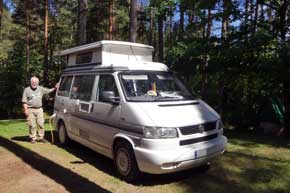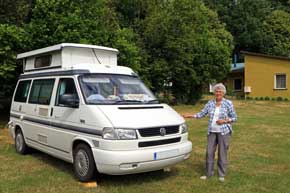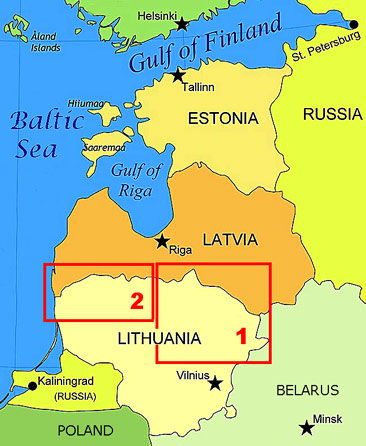 A
Hanseatic Tour of the Baltic 2018 -
North-east and North-west Lithuania: A
Hanseatic Tour of the Baltic 2018 -
North-east and North-west Lithuania:
Kernavė Archaeological Site:
leaving Harmonie Camping on the dusty gravel road through the pine forests (see
below left), we returned to Rūdiškės, and from Trakai headed NW across country
to the Archaeological Reserve at Kernavė, one of Lithuania's most important
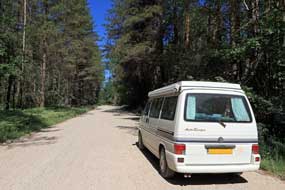 historical
sites (click on Map 1 right for our route). Set in the valley of the meandering Neris River, with ample fresh water
from tributary streams, plentiful food supplies, fertile soil for agriculture
and grazing, and 5 flat-topped hillocks above the valley bottom for protection
in times of threat, the site at Kernavė had been occupied continuously
since the late Palaeolithic 9th millennium BC. The Neris valley had been created
among moraine hills by Ice Age glacial melt-water, with side streams forming
gullies in the alluvium with intervening promontories forming hillocks which
later settlers levelled and fortified with wooden stockade hill-forts for
protection in troubled times. Soon after the retreat of the glaciers, migrant
hunter-gatherers initially set up temporary encampments in the Neris valley
hunting grounds, as evidenced by arrow-heads and other flint artefacts unearthed
at Kernavė from this period. historical
sites (click on Map 1 right for our route). Set in the valley of the meandering Neris River, with ample fresh water
from tributary streams, plentiful food supplies, fertile soil for agriculture
and grazing, and 5 flat-topped hillocks above the valley bottom for protection
in times of threat, the site at Kernavė had been occupied continuously
since the late Palaeolithic 9th millennium BC. The Neris valley had been created
among moraine hills by Ice Age glacial melt-water, with side streams forming
gullies in the alluvium with intervening promontories forming hillocks which
later settlers levelled and fortified with wooden stockade hill-forts for
protection in troubled times. Soon after the retreat of the glaciers, migrant
hunter-gatherers initially set up temporary encampments in the Neris valley
hunting grounds, as evidenced by arrow-heads and other flint artefacts unearthed
at Kernavė from this period.
|
Click on 2 highlighted areas
for details of
NE and NW Lithuania |
 |
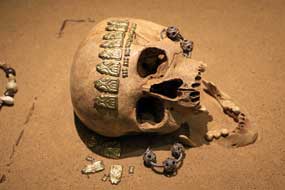 As the climate warmed and the valley became
forested, and with the domestication of plants and animals, the Kernavė
site was settled by Neolithic pastoralists during the 5th~3rd millennia BC. New
waves of migrants of Indo-European origins later settled the area, and during
the early metal age from the 2nd~1st millennia BC, bronze and iron implements
were forged by settlers at Kernavė. Into the early centuries of the Common
Era, the development of metallurgy and widespread use of iron working led to
increased productivity of foodstuffs, improvement in living conditions and
growth in population in the Neris valley by peoples considered ancestors of the
Baltic tribes. The first fortifications were built on the hillocks above the
Pajauta valley at Kernavė by the 3rd~4th centuries AD. Archaeological finds,
including a silver denarius of Marcus Aurelius dated to 161~2 AD showed that trade
developed with the Roman Province of Germania. Further migrations into the
region in the 5~6th centuries AD led to the divergence of the Balts into
distinctive tribes, with the direct ancestors of the Lithuanian people occupying
the tribal centre at Kernavė. The fortification of the Kernavė
hill-forts and prosperity of the township during the 11~13t As the climate warmed and the valley became
forested, and with the domestication of plants and animals, the Kernavė
site was settled by Neolithic pastoralists during the 5th~3rd millennia BC. New
waves of migrants of Indo-European origins later settled the area, and during
the early metal age from the 2nd~1st millennia BC, bronze and iron implements
were forged by settlers at Kernavė. Into the early centuries of the Common
Era, the development of metallurgy and widespread use of iron working led to
increased productivity of foodstuffs, improvement in living conditions and
growth in population in the Neris valley by peoples considered ancestors of the
Baltic tribes. The first fortifications were built on the hillocks above the
Pajauta valley at Kernavė by the 3rd~4th centuries AD. Archaeological finds,
including a silver denarius of Marcus Aurelius dated to 161~2 AD showed that trade
developed with the Roman Province of Germania. Further migrations into the
region in the 5~6th centuries AD led to the divergence of the Balts into
distinctive tribes, with the direct ancestors of the Lithuanian people occupying
the tribal centre at Kernavė. The fortification of the Kernavė
hill-forts and prosperity of the township during the 11~13t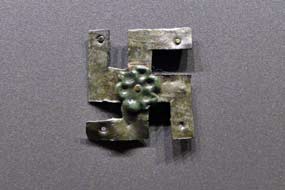 h centuries led to the
consolidation of the Lithuanian Balts into a distinct nation-state during the
reign of Grand Duke Mindaugas (1236~63). Under Grand Duke Traidenis (1269~82), Kernavė
became one of the most important economic and political centres of the Grand
Duchy of Lithuania, with the Duke's residence h centuries led to the
consolidation of the Lithuanian Balts into a distinct nation-state during the
reign of Grand Duke Mindaugas (1236~63). Under Grand Duke Traidenis (1269~82), Kernavė
became one of the most important economic and political centres of the Grand
Duchy of Lithuania, with the Duke's residence
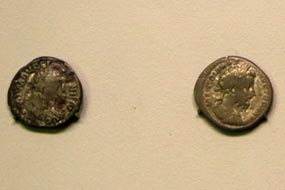 occupying the central hill-fort of Akuras Hill, protected by a defensive system of forts on the surrounding hills.
A township of merchants and craftsmen developed in the Pajauta Valley on the
river's upper terrace at the foot of the hills. This was the period of the
Lithuanian Baltic tribes' conversion from paganism to Christianity. At the
beginning of the 14th century, Grand Duke Gediminas transferred the tribal
centre from Kernavė to Trakai and later to Vilnius. Kernavė continued
for some time as an important economic centre until attacks by the Teutonic
Knights (so-called Crusaders) finally resulted in Kernavė's destruction in
1390. The occupants deserted the settlement in the Pajauta Valley, and the site
was never again occupied. Alluvial deposits from the Neris covered the site and
medieval township, preserving it to be rediscovered by archaeologists in the
20th century. occupying the central hill-fort of Akuras Hill, protected by a defensive system of forts on the surrounding hills.
A township of merchants and craftsmen developed in the Pajauta Valley on the
river's upper terrace at the foot of the hills. This was the period of the
Lithuanian Baltic tribes' conversion from paganism to Christianity. At the
beginning of the 14th century, Grand Duke Gediminas transferred the tribal
centre from Kernavė to Trakai and later to Vilnius. Kernavė continued
for some time as an important economic centre until attacks by the Teutonic
Knights (so-called Crusaders) finally resulted in Kernavė's destruction in
1390. The occupants deserted the settlement in the Pajauta Valley, and the site
was never again occupied. Alluvial deposits from the Neris covered the site and
medieval township, preserving it to be rediscovered by archaeologists in the
20th century.
Shrouded in myths and legends, Kernavė
remains for Lithuanians a symbol of their statehood, the capital of pagan
ancestral tribes where Gediminas welded the Lithuanian Balts into a distinct nation-state and
converted them to Christianity. The name of Kernavė is first mentioned in
the Rhymed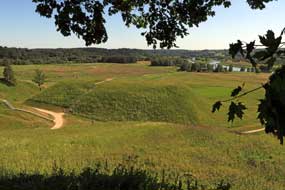 Chronicle and Hermanni de Watberge Chronicon Livoniae,
describing the Teutonic Order's 1279 raid into the Lithuanian realm as far as Kernavė.
Archaeological excavations by Vilnius University began in 1979, producing a
treasure trove of artefacts and grave goods spanning the 11 millennia of the Kernavė
site's occupation until the medieval township's destruction in 1390. These are
now displayed in the Kernavė Archaeological Museum, leading to Kernavė
being dubbed the Troy of Lithuania. Chronicle and Hermanni de Watberge Chronicon Livoniae,
describing the Teutonic Order's 1279 raid into the Lithuanian realm as far as Kernavė.
Archaeological excavations by Vilnius University began in 1979, producing a
treasure trove of artefacts and grave goods spanning the 11 millennia of the Kernavė
site's occupation until the medieval township's destruction in 1390. These are
now displayed in the Kernavė Archaeological Museum, leading to Kernavė
being dubbed the Troy of Lithuania.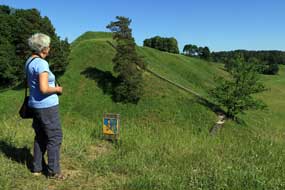
Our visit to Kernavė:
we initially visited the Kernavė Archaeological Museum to gain a fuller
understanding of the site's significance in Lithuanian history, and to view the
impressive and well-documented displays of excavated remains covering the entire
period of Kernavė's occupation, from Palaeolithic flint implements through
to the grave-goods of the medieval period at the time of the Lithuanian Balts'
conversion to Christianity and Kernavė's destruction. The displays included
beautiful medieval head band jewellery (see above left), brooches bearing the
Indo-European swastika emblem (see above right), Roman coins with head of Marcus Aurelius
(see above left), and a
medieval bronze statuette described as Perkūnas the pagan god of thunder
(Photo 1 - Perkūnas statuette).
Beyond the 19th century chapel, a path led over to a view point overlooking the
5 hill-forts, the Pajauta settlement site, and the Neris River meandering around
the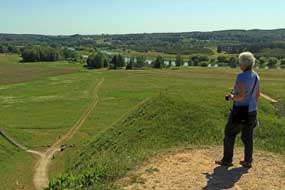 valley beyond. Wooden step-ways led up onto
each of the steep-sided hill-fort sites,
and we climbed Castle Hill with its extensive flat-top site of the Grand Duke's
former residence, and the more narrow Mindaugas Hill. From both these
flat-topped hillocks views opened out of the other hill-forts, the narrow
winding Pajauta valley between them and the wide river terrace beyond, site of
the medieval township (Photo 2 - Kernavė hill-forts)
(see above right).
It was obvious from here why the Kernavė site should have been such an
attractively fertile spot for the original settlement (see right), and an valley beyond. Wooden step-ways led up onto
each of the steep-sided hill-fort sites,
and we climbed Castle Hill with its extensive flat-top site of the Grand Duke's
former residence, and the more narrow Mindaugas Hill. From both these
flat-topped hillocks views opened out of the other hill-forts, the narrow
winding Pajauta valley between them and the wide river terrace beyond, site of
the medieval township (Photo 2 - Kernavė hill-forts)
(see above right).
It was obvious from here why the Kernavė site should have been such an
attractively fertile spot for the original settlement (see right), and an
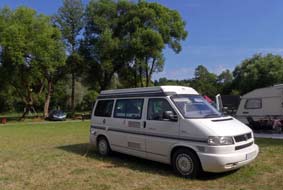 evidently
well-defended location for later Iron Age and medieval fortification (see above
left). Given the
site's historical importance, its magnificent state of preservation, and
invaluable range of archaeological finds representing 11th millennia of
occupation, it was understandable why Kernavė has such significance for
Lithuanians. evidently
well-defended location for later Iron Age and medieval fortification (see above
left). Given the
site's historical importance, its magnificent state of preservation, and
invaluable range of archaeological finds representing 11th millennia of
occupation, it was understandable why Kernavė has such significance for
Lithuanians.
North to Anykščiai and Camping Po Žvaigždėm: we now had a long drive north across
country to camp at Anykščiai in readiness for our planned ride on the
preserved narrow gauge railway tomorrow. Before leaving Kernavė however, we
phoned the Tourist Information Centre in Anykščiai to confirm that the
town's campsite was open. As in 2011, the lady's response in good English was
supremely helpful: yes the campsite was open and she would book space for us
with the warden; she also gave us contact details for tomorrow's railway ride.
From Kernavė, the A2 motorway took us 50kms NW in busy traffic to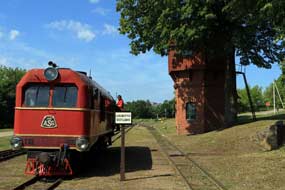 Utmergė (click
here for detailed map of route), then another 36 kms on A6/Route 120 to
the outskirts of the surprisingly large town of Anykščiai. We threaded a
way through the centre, across the river and in the far outskirts found
Camping Po Žvaigždėm (Under the Stars). We had expected this
to be deserted at this early stage of the year, but the riverside campsite was full of families noisily
celebrating Lithuanian Children's Day with party fun and games; it was bedlam!
The young warden was expecting us, having been alerted by the TIC Utmergė (click
here for detailed map of route), then another 36 kms on A6/Route 120 to
the outskirts of the surprisingly large town of Anykščiai. We threaded a
way through the centre, across the river and in the far outskirts found
Camping Po Žvaigždėm (Under the Stars). We had expected this
to be deserted at this early stage of the year, but the riverside campsite was full of families noisily
celebrating Lithuanian Children's Day with party fun and games; it was bedlam!
The young warden was expecting us, having been alerted by the TIC
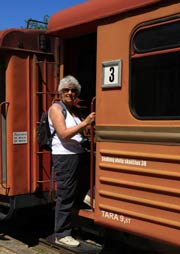 lady of our
arrival, and welcomed us in quaintly formal English. The price was €22/night,
rather expensive for a basic municipal site, but the facilities including a good
kitchen were kept regularly cleaned; with trepidation at all the commotion, we
wearily settled in (see above left). The children's party finished at 9-00pm and peace was
restored. Earlier a text message was received confirming our seats on the Anykščiai
narrow gauge railway, but it was still uncertain as to whether the train would
run. lady of our
arrival, and welcomed us in quaintly formal English. The price was €22/night,
rather expensive for a basic municipal site, but the facilities including a good
kitchen were kept regularly cleaned; with trepidation at all the commotion, we
wearily settled in (see above left). The children's party finished at 9-00pm and peace was
restored. Earlier a text message was received confirming our seats on the Anykščiai
narrow gauge railway, but it was still uncertain as to whether the train would
run.
A ride on the preserved Anykščiai narrow gauge railway:
we needed to be up early the following
morning to be at Anykščiai station by 10-30 to collect tickets for our ride
on the narrow gauge railway. We were relieved to see crowds waiting and the train
being shunted into the platform. The Anykščiai 750mm gauge railway is a surviving part of
the former Tsarist-Russian network of local lines which once connected the rural hinterland to
major towns served by the Russian broad gauge main lines. This line linking Anykščiai
to Panevėžys was built in 1891; it ceased regular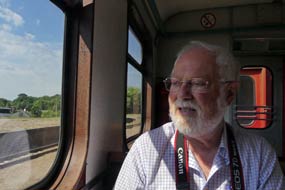 traffic in 2001 but was
re-opened by volunteers as a tourist attraction (see left). At the booking office, our
tickets were waiting, and after photographs of the train we took our reserved
seats
(Photo 3 - Anykščiai narrow gauge railway)
(see right).
The very growly ex-Soviet TU-2 diesel locomotive connected to the coaches (see
above right), and
at 11-00, with the sounding of klaxon horn and ringing of bell, the train
juddered and lurched out of the station for the 20km ride through the forests to
the isolated farming village of Troškūnai (see below left). From the little
rural station-halt, a guided walk in exhaustingly hot sun along field roads took
us to see the monastery church in Troškūnai, but with the commentary only
in Lithuanian we understood little of the church's history. traffic in 2001 but was
re-opened by volunteers as a tourist attraction (see left). At the booking office, our
tickets were waiting, and after photographs of the train we took our reserved
seats
(Photo 3 - Anykščiai narrow gauge railway)
(see right).
The very growly ex-Soviet TU-2 diesel locomotive connected to the coaches (see
above right), and
at 11-00, with the sounding of klaxon horn and ringing of bell, the train
juddered and lurched out of the station for the 20km ride through the forests to
the isolated farming village of Troškūnai (see below left). From the little
rural station-halt, a guided walk in exhaustingly hot sun along field roads took
us to see the monastery church in Troškūnai, but with the commentary only
in Lithuanian we understood little of the church's history.
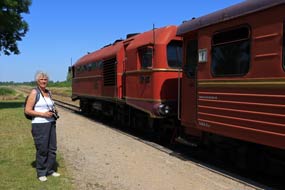 Anykščiai
Holocaust Memorial: back
at Anykščiai we shopped for provisions at the Iki supermarket, and called in
at the TIC to thank the lady for her help; as so often is the case, less well
known and unpretentious places offer the very best of tourist information
services, and Anykščiai's TIC had set a standard which others could do well
to follow. We knew from our 2011 visit that pre-WW2 30% of Anykščiai's and
its neighbouring villages' population had been Jewish, all of whom had
been systematically exterminated by the German occupiers. We wanted to find the
monument marking the mass graves of the 2,500 Jewish people from this small
rural town who had been murdered by the Germans in the surrounding forests.
Just outside the town, a Anykščiai
Holocaust Memorial: back
at Anykščiai we shopped for provisions at the Iki supermarket, and called in
at the TIC to thank the lady for her help; as so often is the case, less well
known and unpretentious places offer the very best of tourist information
services, and Anykščiai's TIC had set a standard which others could do well
to follow. We knew from our 2011 visit that pre-WW2 30% of Anykščiai's and
its neighbouring villages' population had been Jewish, all of whom had
been systematically exterminated by the German occupiers. We wanted to find the
monument marking the mass graves of the 2,500 Jewish people from this small
rural town who had been murdered by the Germans in the surrounding forests.
Just outside the town, a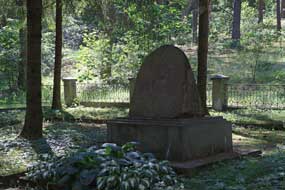 sandy track led into the pine woods, and here we found
the small and sadly neglected Holocaust memorial with an almost faded
inscription and surrounded by a rusty fence (Photo 4 - Anykščiai Holocaust Memorial)
(see right). These now forgotten victims of German institutionalised mass-murder
now lay buried in mass graves in the sandy soil of the forests outside the town. sandy track led into the pine woods, and here we found
the small and sadly neglected Holocaust memorial with an almost faded
inscription and surrounded by a rusty fence (Photo 4 - Anykščiai Holocaust Memorial)
(see right). These now forgotten victims of German institutionalised mass-murder
now lay buried in mass graves in the sandy soil of the forests outside the town.
Arvydas Gaidelis Homestead-Camping at Palūšė:
our original plan had been to camp tonight at Papartis near to Molėtai, but what
in 2011 had been a straightforward site had now been tarted up as a lakeside
'resort' with silly prices to match, the sort of place where Lithuanian
townsfolk flock to party at weekends. We therefore decided to head directly to
Palūšė, and with the campsite there now closed, we had identified a small
guesthouse-camping in the village of Palūšė. In welcoming response to our
telephone enquiry, the owner's son in good
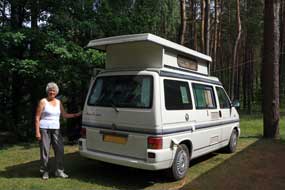 English recalled our earlier exchange
of emails confirming we could camp, and agreed to meet us at the homestead at
6-00pm this evening. We set course on the winding semi-tarmaced Route 119 for
the 44km drive, through Molėtai, an inconsequential little town with oversized
basilica, and joined Route 114 for the delightful 36km drive through pine
forested lakeland to Palūšė (click
here for detailed map of route). We arrived with time to spare, and in
the upper part of the village beyond the wooden church, the former Palūšė
Camping which we had so enjoyed in 2011 was now truly closed. We eventually
found the driveway leading to the homestead-camping, just as the owner Arvydas Gaidelis
arrived with his fluently English-speaking son. With insistent and kindly
hospitality, they English recalled our earlier exchange
of emails confirming we could camp, and agreed to meet us at the homestead at
6-00pm this evening. We set course on the winding semi-tarmaced Route 119 for
the 44km drive, through Molėtai, an inconsequential little town with oversized
basilica, and joined Route 114 for the delightful 36km drive through pine
forested lakeland to Palūšė (click
here for detailed map of route). We arrived with time to spare, and in
the upper part of the village beyond the wooden church, the former Palūšė
Camping which we had so enjoyed in 2011 was now truly closed. We eventually
found the driveway leading to the homestead-camping, just as the owner Arvydas Gaidelis
arrived with his fluently English-speaking son. With insistent and kindly
hospitality, they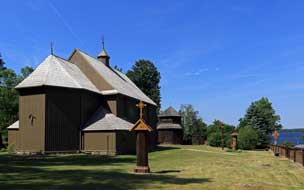 explained that what had been grandmother's house was now being
converted to holiday accommodation, and we were welcome to camp in the
grounds. They opened up, found us power, and left the key so that we could use
the bathroom and kitchen, all for €13/night. We settled in at a flat area
alongside the house in the shade of pine trees, a perfectly peaceful forest
setting for our day in camp tomorrow and visit to Aukštaitija National Park (see left) (Photo 5 - Arvydas Gaidelis Guesthouse-Camping).
We spent a productive rest day at the guesthouse-camping, and Arvydas the owner
broke off from his conversion work to invite us to share morning coffee with him
sat on the veranda. He spoke no English but we manage to converse with him in
German, a truly hospitable man. The facilities in the guest-house were excellent
with full access to both bathroom, kitchen and wi-fi. It was truly a memorable
stay explained that what had been grandmother's house was now being
converted to holiday accommodation, and we were welcome to camp in the
grounds. They opened up, found us power, and left the key so that we could use
the bathroom and kitchen, all for €13/night. We settled in at a flat area
alongside the house in the shade of pine trees, a perfectly peaceful forest
setting for our day in camp tomorrow and visit to Aukštaitija National Park (see left) (Photo 5 - Arvydas Gaidelis Guesthouse-Camping).
We spent a productive rest day at the guesthouse-camping, and Arvydas the owner
broke off from his conversion work to invite us to share morning coffee with him
sat on the veranda. He spoke no English but we manage to converse with him in
German, a truly hospitable man. The facilities in the guest-house were excellent
with full access to both bathroom, kitchen and wi-fi. It was truly a memorable
stay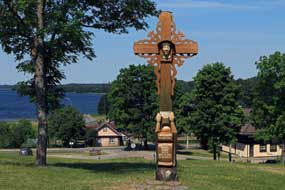 . .
Aukštaitija National Park: first stop this morning was the Aukštaitija
National Park Information Office in Palūšė village for an
English version of the free-issue national park guide book. We also asked more
about the traditional carved wooden Contemplative Christ shrine-statues, called
Rūpintojėlis in Lithuanian, seen in rural parts of the country. Up on the
hillside above the village by the mid-18th century wooden Church of St Jozef (see above right
and left) overlooking Lake Lušiai, such a Rūpintojėlis stood in
the churchyard (Photo
6 - Palūšė Rūpintojėlis). Armed with a
detailed map and good advice from the National Park
office in the village, we
set off from Palūšė for a day's walking among the hillocks and 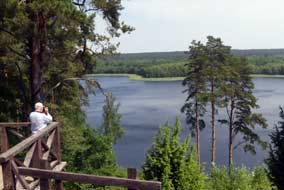 lakes
of the Aukštaitija National Park, turning off onto a
back lane to Antalksnė village where a stork was foraging for prey by the
road-side (Photo
7 - Foraging stork). The Šiliniškės esker-ridge, one of Aukštaitija
National Park's prominent geographical features, starts at the look-out point of
Ladakalnis Hill. This 175m hillock is believed to have been the site of
pre-Christian sacrifices to the pagan goddess Lada, the Great Mother who
according to legend gave birth to the world. It took us all of 10 minutes to
climb steeply to its 'summit', but the view of 6 surrounding lakes made it
worthwhile (see right). The path along the spine of the Šiliniškės esker was delightful with glimpses of surrounding lakes through the pine and oak woods
covering the narrow moraine-ridge (Photo
8 - Šiliniškės esker-ridge). The ridge path led lakes
of the Aukštaitija National Park, turning off onto a
back lane to Antalksnė village where a stork was foraging for prey by the
road-side (Photo
7 - Foraging stork). The Šiliniškės esker-ridge, one of Aukštaitija
National Park's prominent geographical features, starts at the look-out point of
Ladakalnis Hill. This 175m hillock is believed to have been the site of
pre-Christian sacrifices to the pagan goddess Lada, the Great Mother who
according to legend gave birth to the world. It took us all of 10 minutes to
climb steeply to its 'summit', but the view of 6 surrounding lakes made it
worthwhile (see right). The path along the spine of the Šiliniškės esker was delightful with glimpses of surrounding lakes through the pine and oak woods
covering the narrow moraine-ridge (Photo
8 - Šiliniškės esker-ridge). The ridge path led
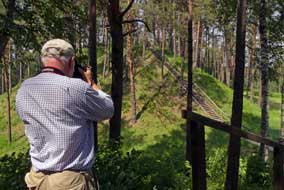 to Ginučiai
castle-mound, an elongated conical hill which had been the site of a 10th
century network of defensive hill-forts built by Lithuanian tribes to withstand
incursions by Teutonic Knights (see left) (Photo
9 - Ginučiai hill-fort). The flat hill-top was crowned by a
memorial stone commemorating a visit in 1934 by the autocratic president of
Lithuania, Antanas Smetona,who had planted an oak at this historic site;
the Soviets destroyed the oak during their long occupation, causing Lithuanians
to treat the place with even greater reverence; Smetona may have been a
dictator, but at least he was a Lithuanian dictator! With the sun filtering down
through the pines, this was a magnificent path with views out across the
Aukštaitija lakes (see below right). to Ginučiai
castle-mound, an elongated conical hill which had been the site of a 10th
century network of defensive hill-forts built by Lithuanian tribes to withstand
incursions by Teutonic Knights (see left) (Photo
9 - Ginučiai hill-fort). The flat hill-top was crowned by a
memorial stone commemorating a visit in 1934 by the autocratic president of
Lithuania, Antanas Smetona,who had planted an oak at this historic site;
the Soviets destroyed the oak during their long occupation, causing Lithuanians
to treat the place with even greater reverence; Smetona may have been a
dictator, but at least he was a Lithuanian dictator! With the sun filtering down
through the pines, this was a magnificent path with views out across the
Aukštaitija lakes (see below right).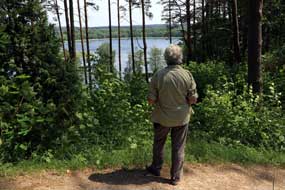
Villages of Aukštaitija National Park:
back along the ridge, we continued with our circular route through the villages
of Aukštaitija National Park. At a junction of lanes just before Kirdeikiai,
we found a classic example of the traditional carved wooden folk-art wayside
shrine incorporating the figure of the Contemplative Christ, the Rūpintojėlis,
seen throughout the country; our photograph may well form the subject of our
2018 Christmas card (see below left) (Photo
10 - Aukštaitija Rūpintojėlis). Reaching Ginučiai
village we found the conserved water-mill, the only one of 6 original
water-mills in Aukštaitija National Park whose early 19th century mechanism is
still in working order (see below right). The
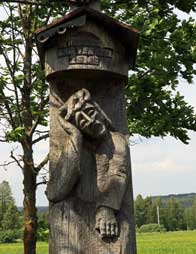 English-speaking young guide showed us around the
mill, and although most of the mechanism was wooden, the design of the
water-mill's metal turbine blades reminded us of modern HEP turbines seen at Porjus generating station in Northern Sweden. Continuing our drive along further
eskers separating small lakes, we reached Trainiškis village where another
ancient carved wooden Rūpintojėlis stood among the cottages.
The final village of Vaišniūnai was a more work-a-day place with farmsteads and
a hill-top graveyard, and from here Route 102 brought us into the small town of
Ignalina for provisions at the Maxima supermarket. English-speaking young guide showed us around the
mill, and although most of the mechanism was wooden, the design of the
water-mill's metal turbine blades reminded us of modern HEP turbines seen at Porjus generating station in Northern Sweden. Continuing our drive along further
eskers separating small lakes, we reached Trainiškis village where another
ancient carved wooden Rūpintojėlis stood among the cottages.
The final village of Vaišniūnai was a more work-a-day place with farmsteads and
a hill-top graveyard, and from here Route 102 brought us into the small town of
Ignalina for provisions at the Maxima supermarket.
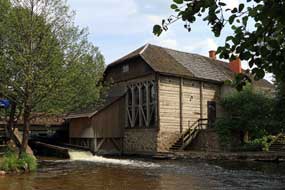 Aukštaitija
National Park Botanical Trail: after a final night at Arvydas Gaidelis
Homestead-Camping, a shift of wind around to the north brought markedly lower
temperatures: 10şC felt positively Arctic after recent days' heat-wave! Before
leaving Palūšė, there was time to walk the 3.5km Aukštaitija Botanical
Trail. The path climbed steeply up from the shore of Lake Lušiai onto a broad
plateau covered with delightful pine, spruce, rowan and oak woods. The forest
floor was a mass of fresh green Bilberry just showing signs of its new
berries and leathery-leaved Lingonberry. Both in the higher forest and lower
moist area by a water-course, the feast of botanical gems truly justified the
path's description, with Lily of the Valley, Stone Bramble, Solomon's Seal, Wood
Sorrel, Cow Wheat, May Lily, Chickweed Wintergreen, Water Avens, Herb Paris, Marsh Spotted Orchids, Marsh Tormentil and Bog Beans. But the prize came when we
crossed the marshland on a board-walk: here among the sphagnum, large clumps of
Cranberry flowers flourished (Photo
11 - Cranberry flowers). The path continued through further woodland meadows to round the head of a lake, climb back onto higher areas of pine
forest, and return along the shore of Lake Lušiai (see below left). It had truly
been a rewarding walk. Aukštaitija
National Park Botanical Trail: after a final night at Arvydas Gaidelis
Homestead-Camping, a shift of wind around to the north brought markedly lower
temperatures: 10şC felt positively Arctic after recent days' heat-wave! Before
leaving Palūšė, there was time to walk the 3.5km Aukštaitija Botanical
Trail. The path climbed steeply up from the shore of Lake Lušiai onto a broad
plateau covered with delightful pine, spruce, rowan and oak woods. The forest
floor was a mass of fresh green Bilberry just showing signs of its new
berries and leathery-leaved Lingonberry. Both in the higher forest and lower
moist area by a water-course, the feast of botanical gems truly justified the
path's description, with Lily of the Valley, Stone Bramble, Solomon's Seal, Wood
Sorrel, Cow Wheat, May Lily, Chickweed Wintergreen, Water Avens, Herb Paris, Marsh Spotted Orchids, Marsh Tormentil and Bog Beans. But the prize came when we
crossed the marshland on a board-walk: here among the sphagnum, large clumps of
Cranberry flowers flourished (Photo
11 - Cranberry flowers). The path continued through further woodland meadows to round the head of a lake, climb back onto higher areas of pine
forest, and return along the shore of Lake Lušiai (see below left). It had truly
been a rewarding walk.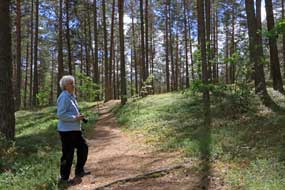
A re-visit to Ignalina Nuclear Power Station,
and many unanswered questions:
beyond Ignalina, we set off on the second part of our day to re-visit the
Ignalina Nuclear Power Station and the town of Visaginas built by the Soviets to
house the power plant's workers (click
here for detailed map of route). Route 102 passed through rolling
agricultural countryside, causing us to observe that during our travels around
Lithuania, we had so far seen little evidence of large scale cereal crops; no fields of wheat, barley and certainly 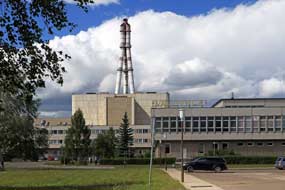 no maize. The countryside seemed to be
confined to meadow-grassland, but with little or none cut for
hay. Other than forests, we had also seen large tracts of seemingly unusable,
infertile land particularly in the south of the country, and along with this
apparent absence of arable farming, we had seen little evidence of cattle or
sheep grazing, just the occasional tethered cow on small-holdings. So with all
this grassland seemingly little used, where was Lithuania's agricultural
production, we wondered? no maize. The countryside seemed to be
confined to meadow-grassland, but with little or none cut for
hay. Other than forests, we had also seen large tracts of seemingly unusable,
infertile land particularly in the south of the country, and along with this
apparent absence of arable farming, we had seen little evidence of cattle or
sheep grazing, just the occasional tethered cow on small-holdings. So with all
this grassland seemingly little used, where was Lithuania's agricultural
production, we wondered?
The Soviets had chosen this remote and
uninhabited NE corner of Lithuania, tucked away among the swamps and forests on
the shores of Lake Drūkšiai in the angle between Latvia, Lithuania and Belarus,
to build Ignalina Nuclear Power Station in 1974. Visaginas had also been built
nearby as a new town of apartment blocks, hacked out of this remote and
inhospitable wilderness, to house the 5,000
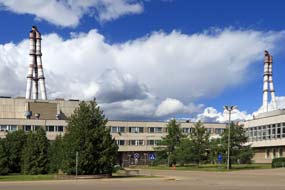 Russian workers and their families
brought in as immigrants from other parts of the USSR. Ignalina, the only
nuclear power station in the Baltic States, had 2 water-cooled, graphite
moderated nuclear reactors of the same design as the Chernobyl plant in Ukraine
which suffered the disastrous melt-down in 1986. Ignalina's Reactor #1 came
on-line in 1984, but Reactor #2 was delayed until 1987 because of Chernobyl. Ignalina's 2 reactors, originally the world's most powerful, had the capacity to
generate an electrical output of 1,500 megawatts. But the plant's design
similarities with Chernobyl and the lack of containment building in the event of
nuclear accident was cited by the EU as ultra high risk, and the power plant's
phased decommissioning was insisted on as a pre-condition to Lithuania's accession
to EU membership in 2004. The Lithuanian government was compelled to accept this
in spite of the economic consequences of finding alternative energy supplies,
given that Ignalina had produced 70% of the country's electrical supply needs.
The EU agreed to Russian workers and their families
brought in as immigrants from other parts of the USSR. Ignalina, the only
nuclear power station in the Baltic States, had 2 water-cooled, graphite
moderated nuclear reactors of the same design as the Chernobyl plant in Ukraine
which suffered the disastrous melt-down in 1986. Ignalina's Reactor #1 came
on-line in 1984, but Reactor #2 was delayed until 1987 because of Chernobyl. Ignalina's 2 reactors, originally the world's most powerful, had the capacity to
generate an electrical output of 1,500 megawatts. But the plant's design
similarities with Chernobyl and the lack of containment building in the event of
nuclear accident was cited by the EU as ultra high risk, and the power plant's
phased decommissioning was insisted on as a pre-condition to Lithuania's accession
to EU membership in 2004. The Lithuanian government was compelled to accept this
in spite of the economic consequences of finding alternative energy supplies,
given that Ignalina had produced 70% of the country's electrical supply needs.
The EU agreed to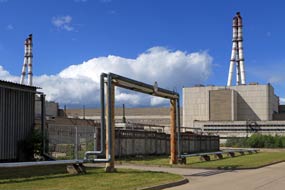 pay €820 million towards decommissioning costs with
compensation payments continuing until 2013. Reactor #1 closed in 2004, followed
by the decommissioning of Reactor #2 in 2009, and construction of improved
containment storage for radioactive waste and spent nuclear fuel rods. The
plant's closure resulted in severe economic, social and political consequences
for Lithuania. It had provided the major source of employment for the people of Visaginas, and EU compensation made little impact on bringing alternative
employment in so remote and isolated a region. Attempts to negotiate financing
with international investment companies of a replacement nuclear plant at
Ignalina have met delays, and any start date remains
pay €820 million towards decommissioning costs with
compensation payments continuing until 2013. Reactor #1 closed in 2004, followed
by the decommissioning of Reactor #2 in 2009, and construction of improved
containment storage for radioactive waste and spent nuclear fuel rods. The
plant's closure resulted in severe economic, social and political consequences
for Lithuania. It had provided the major source of employment for the people of Visaginas, and EU compensation made little impact on bringing alternative
employment in so remote and isolated a region. Attempts to negotiate financing
with international investment companies of a replacement nuclear plant at
Ignalina have met delays, and any start date remains
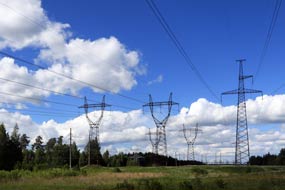 uncertain. Meanwhile
Lithuania has had to bear the cost of extending the capacity of its fossil fuel
generating stations and buying electricity and gas from Russia, placing it at
the mercy of its all-powerful eastern neighbour, a clear cause of concern
particularly since Russia's 2014 annexation of Crimea. Against this background,
we had been able to make a free of charge visit to Ignalina in 2011 to learn
more about the workings of the reactors and the social, political and economic
impact both at local and national level of the EU-enforced closure programme.
Official visits now to Ignalina are charged at more than €50 which was clearly
out of the question. We did however want to find out more while in this part of
Lithuania about what progress had been made in the intervening 7 years with
replacing the power plant's outmoded reactors. We should have to rely on our own
observations. uncertain. Meanwhile
Lithuania has had to bear the cost of extending the capacity of its fossil fuel
generating stations and buying electricity and gas from Russia, placing it at
the mercy of its all-powerful eastern neighbour, a clear cause of concern
particularly since Russia's 2014 annexation of Crimea. Against this background,
we had been able to make a free of charge visit to Ignalina in 2011 to learn
more about the workings of the reactors and the social, political and economic
impact both at local and national level of the EU-enforced closure programme.
Official visits now to Ignalina are charged at more than €50 which was clearly
out of the question. We did however want to find out more while in this part of
Lithuania about what progress had been made in the intervening 7 years with
replacing the power plant's outmoded reactors. We should have to rely on our own
observations.
Beyond Dūkštas, we turned off towards Visaginas
following the branch-line railway that led to Ignalina Nuclear Power Plant. The
approach passed the insulated pipelines which, while Ignalina was operating,
supplied waste steam from the power station to heat Visaginas' apartment blocks.
The pipeline appeared still in well-maintained condition but presumably was no
longer in use since the plant's closure. We turned towards the power station
following the pipeline, and what was immediately evident were the continuous
streams of cars travelling from the plant towards Visaginas. With the 2 former
reactors now decommissioned and the plant no longer generating, we had assumed that
the number of workers would now be much reduced. Clearly however this was not
the case: a shift was now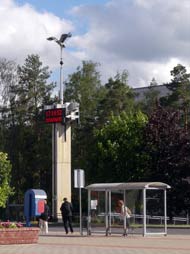 ending with many employees commuting to/from Visaginas.
As we turned into the main Ignalina driveway, huge numbers of cars were emerging
from staff car parks and lines of buses waited to transport workers home. We
paused to allow traffic to clear as staff went off shift, and took our photos of
the prominent triple chimneys of the former #1 reactor (Photo
12 - Ignalina Nuclear Power Station). (see above left and right) What on earth did all
these workers do, we puzzled, if the plant was effectively closed and no longer
generating, with no agreement yet reached on construction of a replacement
western-design replacement reactor? ending with many employees commuting to/from Visaginas.
As we turned into the main Ignalina driveway, huge numbers of cars were emerging
from staff car parks and lines of buses waited to transport workers home. We
paused to allow traffic to clear as staff went off shift, and took our photos of
the prominent triple chimneys of the former #1 reactor (Photo
12 - Ignalina Nuclear Power Station). (see above left and right) What on earth did all
these workers do, we puzzled, if the plant was effectively closed and no longer
generating, with no agreement yet reached on construction of a replacement
western-design replacement reactor?
In search of further answers, we drove along
the rear roadway around to the buildings that had formerly housed the #2 reactor
with the triple exhaust chimney
emerging from its roof
(see above right)
(Photo
13 - Reactor #2 building). There were a number of
newer industrial premises occupying smaller buildings, but we could get no
closer in our search for further information. Back around the front of the main
building, more employees were coming off shift. One of these, who seemed
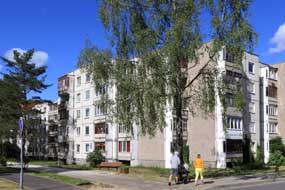 to be
more senior in status, approached us with warnings about our obvious
vulnerability with the plant's security in our taking photographs. We seized the
opportunity to ask questions about Ignalina's status. His replies, full of pride
about the station's capacity, seemed to indicate that the plant was still
generating and feeding the grid. But how was this possible if the reactors were
now de-commissioned, and in that case what did all these staff do? His answers
perhaps reflected a nostalgia for Ignalina's working days, but we were not going
to get more information as he rushed away, clearly embarrassed by our probing
questions. What was the current status of Ignalina? How far have discussions on investment in replacement
reactors reached? Is the plant is generating or not? Are the power lines
emerging from the plant carrying current to the grid or not? (see above left) Neither the Official
Ignalina Nuclear Power Plant web site nor any other web site gives answers to
these questions. Yet we had witnessed 100s of employees coming off shift at Ignalina; what do they all currently work at
with no evident progress on the much vaunted new reactor? Our many questions about Ignalina remained unanswered. But we at least had some photos, and we also beat a hasty retreat
before our presence triggered a security alert! to be
more senior in status, approached us with warnings about our obvious
vulnerability with the plant's security in our taking photographs. We seized the
opportunity to ask questions about Ignalina's status. His replies, full of pride
about the station's capacity, seemed to indicate that the plant was still
generating and feeding the grid. But how was this possible if the reactors were
now de-commissioned, and in that case what did all these staff do? His answers
perhaps reflected a nostalgia for Ignalina's working days, but we were not going
to get more information as he rushed away, clearly embarrassed by our probing
questions. What was the current status of Ignalina? How far have discussions on investment in replacement
reactors reached? Is the plant is generating or not? Are the power lines
emerging from the plant carrying current to the grid or not? (see above left) Neither the Official
Ignalina Nuclear Power Plant web site nor any other web site gives answers to
these questions. Yet we had witnessed 100s of employees coming off shift at Ignalina; what do they all currently work at
with no evident progress on the much vaunted new reactor? Our many questions about Ignalina remained unanswered. But we at least had some photos, and we also beat a hasty retreat
before our presence triggered a security alert!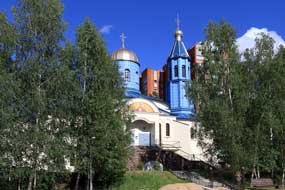
Soviet-built town of
Visaginas:
the last time we visited Visaginas in 2011, many of the blocks of Soviet era
panelaky looked run-down, Russian was the predominant language heard spoken,
and Cyrillic signs could be seen everywhere. Today the town had a curiously more
thriving air, apartment blocks looked less drab, and Lithuanian was heard, no
different from any other Lithuanian town. We drove around the ring road, and cut
through to the Iki supermarket for our shopping, where the lady at the check-out
addressed us in Lithuanian. After photos of the town's Soviet era panelaky at
Partizanų gatvė
(Photo
14 - Soviet era panelaky at Visaginas) (see above left), we circled around
the highway passing the monument displaying today's date which once also
incorporated radiation levels from its Geiger counter (see above right), proudly
announcing that the nearby presence of Soviet-designed
nuclear reactors posed no
environmental threat (try telling that to the former citizens of Chernobyl!). We
eventually located the Russian Orthodox
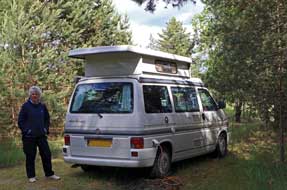 church built to serve the town's once
Russian dominated population of Ignalina workers (see right). Like the
power plant, Visaginas in 2018 posed unanswered questions about how, in spite of the
unemployment assumed from Ignalina's reported closure, the town now seemed
enigmatically lively and prosperous. church built to serve the town's once
Russian dominated population of Ignalina workers (see right). Like the
power plant, Visaginas in 2018 posed unanswered questions about how, in spite of the
unemployment assumed from Ignalina's reported closure, the town now seemed
enigmatically lively and prosperous.
NW to Zarasai:
returning to Route 102, we headed NW towards Zarasai (click
here for detailed map of route) and joined Route 6 into the town which
stood so close to the Latvian border. We had stayed at Zarasai Camping in 2011
and pitched this evening in the tree-sheltered enclosure tucked away in the
corner overlooking the lake (see left). After the last few weeks' heat-wave
conditions, our instinct was for shade from the hot sun in readiness for
tomorrow's rest day, but in contrast today we needed shelter from the
northerly wind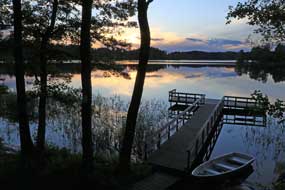 blowing from across the lake. We struggled to pitch against the wind, shivering
in the chill air. Such a change in temperature was a total surprise, and by the
time we were settled, we needed sweaters, roof vents closed against the cold
drafts, and even the fan-heater on; unimaginable after recent weather. What a
multi-aspect today had been; orchids to atoms, forests to panelaky, and
we cooked supper still perplexed by the unanswered questions raised by Ignalina
NPP and Visaginas.
blowing from across the lake. We struggled to pitch against the wind, shivering
in the chill air. Such a change in temperature was a total surprise, and by the
time we were settled, we needed sweaters, roof vents closed against the cold
drafts, and even the fan-heater on; unimaginable after recent weather. What a
multi-aspect today had been; orchids to atoms, forests to panelaky, and
we cooked supper still perplexed by the unanswered questions raised by Ignalina
NPP and Visaginas.
A day in camp at Zarasai Camping:
a chill night, and although the wind had dropped, the weather remained cool
and overcast for our day in camp. Zarasai Camping was a straightforward little
site, and with its friendly welcome, lovely lakeside setting, good facilities
and reasonable price of €17/night, it
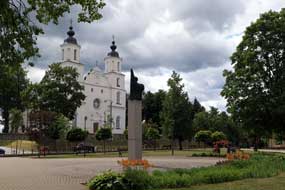 still deserved its +5 rating. We settled up
with the wardens, a smilingly friendly elderly couple, she speaking German
and he speaking hesitant English. Their young grandson was visiting from
Belfast; imagine a little Lithuanian lad speaking English with a broad Ulster
accent! Late afternoon the cloud broke to give evening sun, and after supper we
walked down to the lake for sunset photos through the silhouetted trees from the
landing-stage looking across Lake Zarasai (see above right)
(Photo
15 - Sunset across Lake Zarasai). still deserved its +5 rating. We settled up
with the wardens, a smilingly friendly elderly couple, she speaking German
and he speaking hesitant English. Their young grandson was visiting from
Belfast; imagine a little Lithuanian lad speaking English with a broad Ulster
accent! Late afternoon the cloud broke to give evening sun, and after supper we
walked down to the lake for sunset photos through the silhouetted trees from the
landing-stage looking across Lake Zarasai (see above right)
(Photo
15 - Sunset across Lake Zarasai).
A visit to Zarasai:
we woke to a sunny morning, and before moving on today back into Central
Lithuania, we paid a brief re-visit to Zarasai. This modest and unassuming
little town grew from a 16th century rural settlement, and was formally laid out
with Tsarist era town planning around a grid of streets radiating from the
parkland central town square of Sėlių Aikštė. The town developed over a
peninsula of Lake Zarasai along the Kaunas~Daugavpils section of the
Warsaw~St Petersburg highway, the completion of which in 1830 is celebrated by a
prominent commemorative obelisk on Vytauto gatvė. We shopped for provisions at
the Maxima supermarket before parking at Sėlių Aikštė, calling in a the
council offices for a town plan, and walking across the attractively tree-shaded
parkland to photograph Zarasai's grandiose neo-Baroque St Mary's Ascension
church, built at the time of the 19th century expansion of the town (Photo
16 - St Mary's Ascension church at Zarasai) (see above left).
Utena and the Museum of the Struggles for Freedom:
leaving Zarasai, we headed SW back into Lithuania's
heartlands on the Route 6 highway, the modern successor to the 19th century
Tsarist road linking cities of the Empire (click
here for detailed map of route). Despite the numbers of heavy trucks
seen passing through Zarasai, Route 6 was remarkably traffic-free, cutting a
straight course across the undulating rural countryside. Again we remarked on
the seemingly under-usage made of Lithuania's vast agricultural land resources,
with endless tracts of uncut, un-grazed grassland. We covered the 50kms in less
than an hour to approach the outskirts of Utena, rated by us as Lithuanian
Non-Entity Town of the Year on our 2011 visit. Earlier today, we had tried
phoning the Utenos Brewery, part of the Carlsberg Empire, in a attempt to
arrange a visit. In line with our 2011 experience, there was no reply. We did
however receive a return call to say that, although brewery visits were limited
to groups of 10 or more, someone would try to arrange something for us; a
further call said that no one was available so no brewery visit would be
possible. It cannot be said that we were disappointed; so far we had
consistently avoided Utenos beers as being, like all the Carlsberg products,
little better than coloured water! With little or no expectations of Utena, we
drove along the main street of Basanavičiaus gatvė in search of the TIC,
passing the statue of the eponymous 19th century ideologist of the Lithuanian
national movement at the central cross-roads. The coordinates led to the far end
of town, an unlikely location for the tourist office so remote from the centre.
But this turned out to be Utena's former railway station, now converted to TIC
with decorative statuesque figures waiting on the platform for a train that
would now no longer arrive. The erstwhile station at Utena had been on the same
narrow gauge line as Anykščiai linking to the main Soviet broad gauge main line
at Panevėžys. Inside the 2 members of staff sat guard over piles of mostly
outdated brochures all relating to places other than Utena. It almost seemed a
tacit acknowledgement that no one would want to visit such a non-entity place as
Utena! With apparent surprise at having customers, the ladies served us with
unaccustomed enthusiasm, managing to find a glossy booklet filled with trivial
irrelevancies about the Utena region. Our chance observation that 2018 marked
the 27th anniversary of Lithuania regaining independence prompted her to mention
a small museum next door recalling the evil years of Soviet occupation. The
museum's attendant seemed equally surprised to receive interest, but in fact the Utena Museum of the Struggles for Freedom had well-presented displays,
documented with English translations, detailing the Stalin-led occupation of
Lithuania, deportations and loss of freedom, collectivization of agriculture,
forced conscription of Lithuanians into the Red Army, and partisan resistance
until as late as 1965. The museum's theme of post-WW2
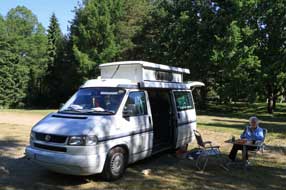 repression in Lithuania,
with emphasis on the Utena region, was contrasted with the same period of
freedom and recovery in Western Europe with the foundation of NATO, UNICEF and
the Welfare State. This modest little museum with its charmingly unassuming
attendant must rank as Utena's one and only worthwhile highlight and we were glad
to have discovered it despite the lack of publicity. repression in Lithuania,
with emphasis on the Utena region, was contrasted with the same period of
freedom and recovery in Western Europe with the foundation of NATO, UNICEF and
the Welfare State. This modest little museum with its charmingly unassuming
attendant must rank as Utena's one and only worthwhile highlight and we were glad
to have discovered it despite the lack of publicity.
Sudeikiai Camping near Utena: with nothing else in Utena to detain us, we drove back through
the town and turned off for the 8kms out to Sudeikiai Camping. On our stay here
in 2011, this lakeside municipal campsite had been rated as overpriced compared
with the equivalent site at Zarasai. Apart from a lone Dutch camping-car, the
place was deserted, and we pitched down at the far end in an open area, less
concerned now with seeking shade from trees despite the sun being warm.
Facilities were identical to those at Zarasai with a well-equipped
kitchen/common room. Reception was deserted but the young warden called round
later for payment of the charge, now reduced to a more reasonable €16/night. The
following morning a bright, warm sun rose above the surrounding trees, and
fieldfares pecked around as we sat out for breakfast in the campsite's peaceful
parkland (see right). When it came to washing up however, we found the kitchen/common room locked. A phone call to the campsite number to request that
someone attend to open up, followed by a 20 minute wait and need for a second
phone call added to the frustration, delaying our being able to get away for
today's long drive to the Biržai region.
NW to the Biržai region: Route 118 took us
north-westwards towards Kupiskis (click
here for detailed map of route). After seeing little traces of active
agriculture in other parts of the country, we now travelled through a
well-farmed region with fields cut for baled hay, sizeable herds of grazing
dairy cattle, and large scale arable farming with fields of ripening wheat and
rye. The sun
this morning was dazzlingly bright, making this a long and wearying
drive, but beyond the large farming village of Vabalninkas, we eventually
approached Biržai. Lithuania's northernmost town of Biržai
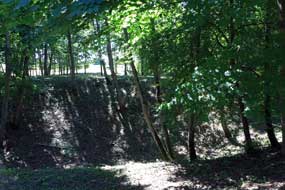 developed as a
trading post from the 15th century under the ownership of the aristocratic
Radvila family. The town's fortified castle was built by Duke Kristupas Radvila
the Thunderer in 1586 to guard the northern frontier of the Lithuanian Grand
Duchy. It was twice destroyed by the invading Swedish Empire during the Northern
Wars and finally abandoned in the early 18th century, with only parts of a
ruined gateway surviving of the original castle. The fortress was restored and
reconstructed as a Renaissance palace in the 1980s, and now houses the town
library and museum. Biržai's other claim to fame is the stately Astravas Manor
built as a summer retreat by the Tyszkiewicz family in the 1860s after the
Radvilas had sold them the Biržai estates in 1812. The manor stands on the
northern shore of Lake Šivėna, created artificially in 1575 by damming the
confluence of the Apaščia and Agluona Rivers as part of the town's defences. The
lake is spanned by a 525m long wooden footbridge built in 1928 to link Astravas
Manor to the town. developed as a
trading post from the 15th century under the ownership of the aristocratic
Radvila family. The town's fortified castle was built by Duke Kristupas Radvila
the Thunderer in 1586 to guard the northern frontier of the Lithuanian Grand
Duchy. It was twice destroyed by the invading Swedish Empire during the Northern
Wars and finally abandoned in the early 18th century, with only parts of a
ruined gateway surviving of the original castle. The fortress was restored and
reconstructed as a Renaissance palace in the 1980s, and now houses the town
library and museum. Biržai's other claim to fame is the stately Astravas Manor
built as a summer retreat by the Tyszkiewicz family in the 1860s after the
Radvilas had sold them the Biržai estates in 1812. The manor stands on the
northern shore of Lake Šivėna, created artificially in 1575 by damming the
confluence of the Apaščia and Agluona Rivers as part of the town's defences. The
lake is spanned by a 525m long wooden footbridge built in 1928 to link Astravas
Manor to the town.
Our reason for visiting this far northern area
of Lithuania almost at the Latvian border was that Biržai is curiously a region
of Karstic limestone with over 9,000 sink holes where underground dissolution of the soft white gypsum by percolating groundwater has caused subsidence. The
surface layer of soil and vegetation collapses creating sink holes. This area of
Karst topography is an outcropping of Devonian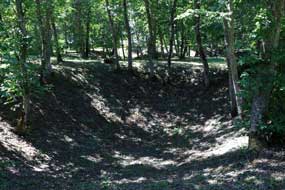 limestone bedrock emerging from
the overlaying covering of glacial alluvium spread by the retreating glaciers of
the last Ice Age which makes up most of the Baltic landscape. limestone bedrock emerging from
the overlaying covering of glacial alluvium spread by the retreating glaciers of
the last Ice Age which makes up most of the Baltic landscape.
Hot and weary after a long drive, we made first for the Biržai Regional Park
Information Office for maps and details of the sink holes. We were greeted
by a youngster from Georgia working here on an EU exchange scheme before
completing his university education back at Tbilisi. In commendably fluent
English, he explained the geological nature of the Karstic terrain and the
subterranean dissolution resulting in sudden surface subsidence forming sink
holes, and showed us core samples of gypsum from regional bore holes. In
addition to this geological background understanding, we also gained maps and
the locations of the principal sink holes and other Karstic features. It was an
interesting encounter and we also learned more about Georgia, a
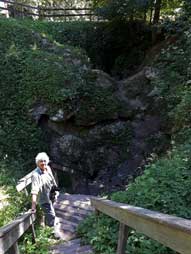 country about
which we had known little. We stocked up with provisions at the Biržai Iki
supermarket, having learned that Iki in Lithuanian means See you soon
(as opposed to the more formal Viso gero for Goodbye). At the TIC,
we got details of Biržai's micro-breweries, for which the town was renowned. The
largest of these was Rinkuškiai Brewery which we found on the far side of town.
It was clearly a sizeable and enterprising micro-brewery, profitably geared to
restaurant trade and beer-tasting, with large groups of visitors. We bought a
range of their beers, and arranged a visit to the brewery tomorrow after our
tour of the Karst sink holes. country about
which we had known little. We stocked up with provisions at the Biržai Iki
supermarket, having learned that Iki in Lithuanian means See you soon
(as opposed to the more formal Viso gero for Goodbye). At the TIC,
we got details of Biržai's micro-breweries, for which the town was renowned. The
largest of these was Rinkuškiai Brewery which we found on the far side of town.
It was clearly a sizeable and enterprising micro-brewery, profitably geared to
restaurant trade and beer-tasting, with large groups of visitors. We bought a
range of their beers, and arranged a visit to the brewery tomorrow after our
tour of the Karst sink holes.
Biržai Camping: Biržai's municipal
camp site, established only 4 years ago, is set in a delightfully grassy area by
Lake Šivėna and the town stadium, and shaded by mature oak trees. We were
greeted with ebullient enthusiasm by the young warden who insisted on giving us
further details of the town's attractions when, weary after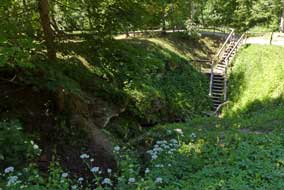 a long day, all we
wanted to do was to get pitched under the shady oak trees and relax with bottles
of Rinkuškiai beers! Our peaceful evening was enlivened by a football match at
the neighbouring stadium, and later a magnificent sunset and after-glow over the
lake. a long day, all we
wanted to do was to get pitched under the shady oak trees and relax with bottles
of Rinkuškiai beers! Our peaceful evening was enlivened by a football match at
the neighbouring stadium, and later a magnificent sunset and after-glow over the
lake.
A day in
Biržai's Karst limestone country: reserving our pitch, we set off the following
morning for our day of exploration around Biržai's Karst limestone
country, and just 1km on the far side of the town we reached the parking area
for the most well known of the Karst features. The entire woodland area was
riddled with depressions and sink holes (Photo
17 - Karst sink holes) (see above left and right), where dissolution of the subterranean
soft gypsum had over the years caused subsidence. A path led over to the largest
of the sink holes, the so-called Cow Hole (Karvės Ola), where steep wooden steps
led down into the bottom of the 12m deep, 10m wide pit (Photo
18 - Cow Hole Karst sink hole) (see above left and right). The limestone strata,
exposed by the severe subsidence which had created the pit, were visible just
below the shallow surface soil and vegetation. Rather
hesitantly we scrambled
down into the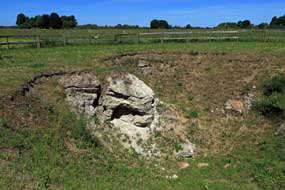 base of the pit, and examined other nearby sink holes and
depressions dotted among the surrounding woodland. base of the pit, and examined other nearby sink holes and
depressions dotted among the surrounding woodland.
The lane led along to the Geologists' Sink Hole,
where in 2003 a wide depression had opened up in open agricultural countryside,
revealing the white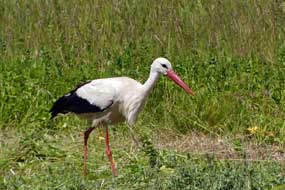 limestone strata just below the surface soil (see left) (Photo
19 - Geologists' sink hole). Nearby adult storks were foraging to feed this year's
growing young
(see right) (Photo
20 - Foraging stork), and a flock
of 12 storks foraging for prey followed a tractor as it cut grass for hay (Photo
21 - Storks foraging behind tractor). We
followed the Geological Trail which looped around on a board-walk among wide
sink holes clustered in the woodland. Again the depressions showed how close to
the ground surface the strata of gypsum and dolomite limestone lay. Back to the
parking area, we set a course north on Route 190 towards the Latvian border in
search of some the other Karst features we had been told about (click
here for detailed map of route). The road led past modern farms with
dairy cattle and arable crops, but the agricultural countryside was also dotted
with the decaying concrete remains of collective farms from the period of Soviet
occupation. The current day more affluent-looking farms showed clearly how much
more productive the land use now was compared with the communist era enforced
collectivization. Reaching the border at Germaniškis village, the main road went
ahead to the border-crossing into Latvia; we turned off onto a very dusty gravel
road which followed the limestone strata just below the surface soil (see left) (Photo
19 - Geologists' sink hole). Nearby adult storks were foraging to feed this year's
growing young
(see right) (Photo
20 - Foraging stork), and a flock
of 12 storks foraging for prey followed a tractor as it cut grass for hay (Photo
21 - Storks foraging behind tractor). We
followed the Geological Trail which looped around on a board-walk among wide
sink holes clustered in the woodland. Again the depressions showed how close to
the ground surface the strata of gypsum and dolomite limestone lay. Back to the
parking area, we set a course north on Route 190 towards the Latvian border in
search of some the other Karst features we had been told about (click
here for detailed map of route). The road led past modern farms with
dairy cattle and arable crops, but the agricultural countryside was also dotted
with the decaying concrete remains of collective farms from the period of Soviet
occupation. The current day more affluent-looking farms showed clearly how much
more productive the land use now was compared with the communist era enforced
collectivization. Reaching the border at Germaniškis village, the main road went
ahead to the border-crossing into Latvia; we turned off onto a very dusty gravel
road which followed the
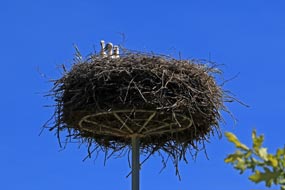 meandering course of the border river. We had been given
the locations of dolomite limestone outcrops along the river, where the river's
embankment revealed these exposed features of the Karstic landscape. We bumped
along the gravel road for 3kms just on the Lithuanian side of the river bank,
reaching the turning to the first outcrop at the Vilniapilis Cave. But in this
afternoon's hot temperatures, there was neither time nor inclination to walk the
2kms of footpath to find the cave. We continued along the gravel road, and by a meandering course of the border river. We had been given
the locations of dolomite limestone outcrops along the river, where the river's
embankment revealed these exposed features of the Karstic landscape. We bumped
along the gravel road for 3kms just on the Lithuanian side of the river bank,
reaching the turning to the first outcrop at the Vilniapilis Cave. But in this
afternoon's hot temperatures, there was neither time nor inclination to walk the
2kms of footpath to find the cave. We continued along the gravel road, and by a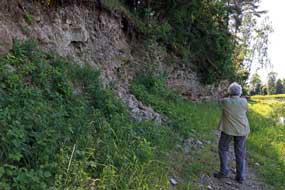 farmstead paused to photograph a stork's nest with 3 chicks awaiting the return
of the parent bird bringing food (see left) (Photo
22 - Stork chicks on nest).
For over a month now since Northern Poland, we had regularly been seeing both
adult storks incubating eggs and newly hatched chicks already growing. Reaching
the Lithuanian border village of Nemunėlio Radviliškis, there was no
border-crossing over the river but the gravel lane curved along the border on
the Lithuanian side. By a Lithuanian border-marker, wooden steps descended
steeply to the river bank where erosion had exposed a 4m high wall of the
Muoriškiai outcropping dolomite. Interesting as it was however, it scarcely
seemed worth the distance we had driven on dusty gravel roads to find it!
farmstead paused to photograph a stork's nest with 3 chicks awaiting the return
of the parent bird bringing food (see left) (Photo
22 - Stork chicks on nest).
For over a month now since Northern Poland, we had regularly been seeing both
adult storks incubating eggs and newly hatched chicks already growing. Reaching
the Lithuanian border village of Nemunėlio Radviliškis, there was no
border-crossing over the river but the gravel lane curved along the border on
the Lithuanian side. By a Lithuanian border-marker, wooden steps descended
steeply to the river bank where erosion had exposed a 4m high wall of the
Muoriškiai outcropping dolomite. Interesting as it was however, it scarcely
seemed worth the distance we had driven on dusty gravel roads to find it!
Yet another WW2 German atrocity:
turning back into Nemunėlio Radviliškis, a brown sign pointed to the site
of WW2 Jewish mass murders by German troops in the nearby forests. After
following the path however for over a kilometre into the pine forest, we had
found no memorial, and had now run out of time; the dark forests would keep
their hidden secrets of the evil events of August 1941, when German
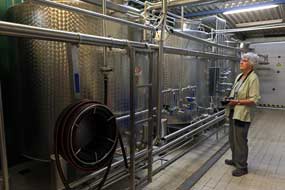 einsatzgruppe killing squads, following on behind the Wehrmacht invasion of
the Baltic States, had murdered the village's 80 strong Jewish population, men
women and children, in the neighbouring forests. Such mass killings of Jews by
the German invaders were systematically repeated at a total of 258 towns and villages across Lithuania. Let us not air-brush out
of historical narrative who actually
committed such atrocities, by einsatzgruppe killing squads, following on behind the Wehrmacht invasion of
the Baltic States, had murdered the village's 80 strong Jewish population, men
women and children, in the neighbouring forests. Such mass killings of Jews by
the German invaders were systematically repeated at a total of 258 towns and villages across Lithuania. Let us not air-brush out
of historical narrative who actually
committed such atrocities, by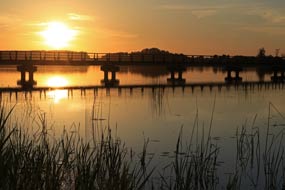 making politically correct, sanitised reference to
Nazis, as if these were some distinct and anonymous microcosm; let us
instead be brutally frank: we all know which European nation bears everlasting responsibility for the Holocaust.
making politically correct, sanitised reference to
Nazis, as if these were some distinct and anonymous microcosm; let us
instead be brutally frank: we all know which European nation bears everlasting responsibility for the Holocaust.
Visit to Rinkuškiai Brewery: it was
by now 4-25pm and we had 35 minutes to drive back to Biržai for our visit to Rinkuškiai
Brewery. We drove purposely back into the town, reaching the micro-brewery with
minutes to spare, and joined the group for the brewery tour. Rinkuškiai Brewery
was founded in 1991, starting from a small, family-run home-brewing concern to
develop into the successful enterprise of today, as one of Lithuania's largest
micro-breweries, building on Biržai's long-standing brewing heritage. They now
produce a wide range of both light and dark beers of outstanding quality as our
tasting proved. The
guide's commentary was in Lithuanian, but she gave a brief summary in English
for our benefit. We viewed the mash tuns, wort boiling coppers, steel fermenting vessels,
filtration plant and maturing vats, ending at the bottling plant and brewery
museum. At Rinkuškiai we had managed to pull off our first brewery
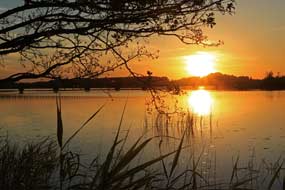 visit of this trip (see
left) (Photo
23 - Rinkuškiai Brewery). visit of this trip (see
left) (Photo
23 - Rinkuškiai Brewery).
A day in camp at Biržai Camping:
back at Biržai Camping, the site was busier and noisier tonight with groups of
summer weekenders, but we moved away from the worst of these closer to
reception, bringing us into range of the campsite wi-fi ready for our day in
camp here tomorrow. On the Sunday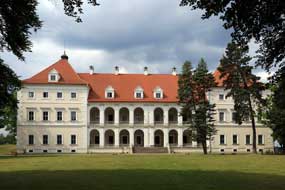 morning, most of the weekend campers left,
leaving us to enjoy a gloriously peaceful and productive afternoon of warm
sunshine under the dappled shade of the tall oak trees. And that evening after
supper, we walked around to the lake for photos of the sun declining behind Biržai's
long wooden footbridge (Photo
24 - Declining sun over Biržai footbridge) (see above right) and setting across the lake against the
silhouetted lake shore trees (see left) (Photo
25 - Sunset over Lake Šivėna). The setting sun's golden light somehow emphasised
the footbridge's length spanning lake Šivėna
(Photo
26 - Biržai footbridge at sunset).
Back at the campsite, the sunset after-glow still
gave a late golden lighting to the camper among the oak trees (Photo
27- Sunset after-glow at Biržai Camping). morning, most of the weekend campers left,
leaving us to enjoy a gloriously peaceful and productive afternoon of warm
sunshine under the dappled shade of the tall oak trees. And that evening after
supper, we walked around to the lake for photos of the sun declining behind Biržai's
long wooden footbridge (Photo
24 - Declining sun over Biržai footbridge) (see above right) and setting across the lake against the
silhouetted lake shore trees (see left) (Photo
25 - Sunset over Lake Šivėna). The setting sun's golden light somehow emphasised
the footbridge's length spanning lake Šivėna
(Photo
26 - Biržai footbridge at sunset).
Back at the campsite, the sunset after-glow still
gave a late golden lighting to the camper among the oak trees (Photo
27- Sunset after-glow at Biržai Camping).
Biržai Castle and War Memorial: the following morning, after our
memorable weekend stay at Biržai's delightful little campsite, we drove into
town and parked by the Castle. Nearby stood the Biržai Monument to those
killed in the 1917~20 Lithuanian War of Independence (Photo
28 - Independence War Memorial). The original red granite statue of a
grieving mother was created by sculptor Robertas Antinis in 1931. In 1945 the
Soviets destroyed the original monument to make way for the Red Army military
cemetery. The buried fragments of the statue were used by Antinis' artist son to
re-create a copy of the original monument
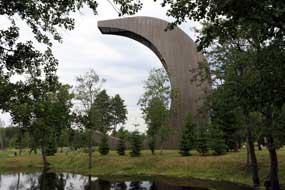 which now stands by the memorial
gardens, with a large section of the original now under a wooden canopy set
alongside. The Castle's scant remains are approached across a sturdy draw-bridge
over the dry moat and beyond the surrounding rampart walls, the vista opened up
across parkland of the reconstructed palace which now stands by the memorial
gardens, with a large section of the original now under a wooden canopy set
alongside. The Castle's scant remains are approached across a sturdy draw-bridge
over the dry moat and beyond the surrounding rampart walls, the vista opened up
across parkland of the reconstructed palace 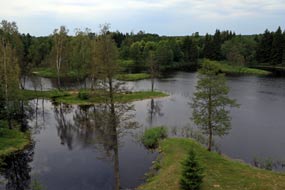 (see above right) (Photo
29 - Biržai Castle). (see above right) (Photo
29 - Biržai Castle).
Kirkilai Viewing Tower over Karst Lakes:
before leaving Biržai, we drove to the farming hamlet of Kirkilai where an
extensive area of sink holes has flooded to form a series of Karst lakes. At the
edge of the village, an upright crescent-shaped 32m high viewing tower has been
constructed overlooking the lakeland. Although a well-known local attraction
bringing hordes of visitors to the village, we feared that such an incongruous
structure, visible for miles around in the flat countryside, would form an alien
intrusion into the natural landscape. 1km along a dusty gravel road, we reached
the tower, and in fact, despite its huge height, when close up its natural wood
facing helped it to blend into the landscape and surrounding trees (see above
left) (Photo
30 - Kirkilai Viewing Tower). Overwhelmed with visitors at the weekend, on a
Monday morning the car park was deserted. At almost 100 feet up its lattice
metal steps, today's wind whistled around the tower, an unnerving climb but giving exhilarating views
over the Karst lakes landscape (see right)
(Photo 31 - Karstic lakeland).
Westwards to Šiauliai: after a final stop at Rinkuškiai Brewery for
more of their excellent beer, we finally left Biržai and in drizzly rain began
our 100km drive westwards to Šiauliai (click
here for detailed map of route). Biržai had certainly been one of our
favourite Lithuanian towns, a very special couple of days stay in Karst country
unique in the Baltics. With the now dull, drizzly weather giving the flat
farming landscape an even more dreary air, we made good progress on Route 125
over to Pasvalys where we joined a short stretch of the A10 Via Baltica to
bypass this insignificant industrial town. A further stretch on Route 150 across
the tediously flat farming countryside in dreary weather brought us to Pakruojis,
another one-horse, industrial town, and continued
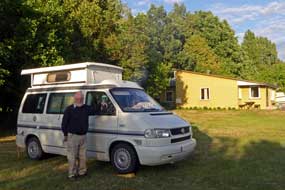 on to reach the outskirts of Šiauliai,
(pronounced Shy-ow-ley), Lithuania's 4th largest city. on to reach the outskirts of Šiauliai,
(pronounced Shy-ow-ley), Lithuania's 4th largest city.
Originally a Lithuanian frontier town bordering on
territory controlled by the Livonian Knights, Šiauliai began to develop as an
agricultural and trading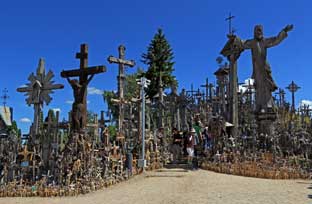 centre after the Teutonic threat was finally removed
with the Knights' defeat at Grunwald in 1410. As a developing market town, Šiauliai
profited by its location on the Königsberg~Riga highway, which also however laid
it open to later threat from Swedish and Russian invasions. Under the Tsarist
Empire, Šiauliai developed further as an industrial town, connected by railway
to Klaipėda and St Petersburg, becoming a centre of leather tanning and
shoe-making. By the beginning of the 20th century, over half of Šiauliai's
16,000 population were Jewish. During WW1 most of the town's buildings were
destroyed, and with reconstruction during Lithuania's early independence, Šiauliai
produced most of the country's leather and footwear, establishing new markets
with links to Western Europe. The Germans captured the city in June 1941, and
immediately began the systematic killing of Šiauliai's large Jewish
population in the nearby forests; by the end of 1941, some 8,000 of Šiauliai's
Jews had been murdered. As the Red Army began its westward advance in 1944~45,
most of the city was again destroyed, and during the post-war Soviet occupation,
Šiauliai was rebuilt with its current grid plan. The Soviets constructed a enormous
military airfield near to Šiauliai, which, after independence in 1991 and
Lithuania joining NATO, became and still is a NATO airbase.
centre after the Teutonic threat was finally removed
with the Knights' defeat at Grunwald in 1410. As a developing market town, Šiauliai
profited by its location on the Königsberg~Riga highway, which also however laid
it open to later threat from Swedish and Russian invasions. Under the Tsarist
Empire, Šiauliai developed further as an industrial town, connected by railway
to Klaipėda and St Petersburg, becoming a centre of leather tanning and
shoe-making. By the beginning of the 20th century, over half of Šiauliai's
16,000 population were Jewish. During WW1 most of the town's buildings were
destroyed, and with reconstruction during Lithuania's early independence, Šiauliai
produced most of the country's leather and footwear, establishing new markets
with links to Western Europe. The Germans captured the city in June 1941, and
immediately began the systematic killing of Šiauliai's large Jewish
population in the nearby forests; by the end of 1941, some 8,000 of Šiauliai's
Jews had been murdered. As the Red Army began its westward advance in 1944~45,
most of the city was again destroyed, and during the post-war Soviet occupation,
Šiauliai was rebuilt with its current grid plan. The Soviets constructed a enormous
military airfield near to Šiauliai, which, after independence in 1991 and
Lithuania joining NATO, became and still is a NATO airbase.
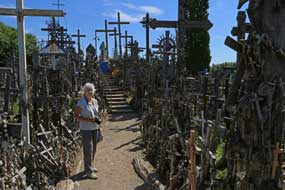 Gražina Sodyba-Camping at Šiauliai: we drove into the city centre
amid roadworks and some of the busiest traffic so far, and found our way to a
large shopping mall for provisions at a Rimi hypermarket. Passing through grubby
industrial suburbs, we headed out to Gražina Sodyba-Camping where Gražina Sodyba-Camping at Šiauliai: we drove into the city centre
amid roadworks and some of the busiest traffic so far, and found our way to a
large shopping mall for provisions at a Rimi hypermarket. Passing through grubby
industrial suburbs, we headed out to Gražina Sodyba-Camping where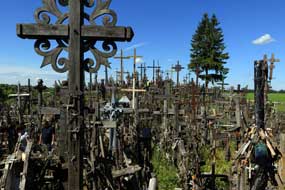 we had stayed
in 2011, and in the northern city outskirts, we found the little guest-house
with its garden camping area (see above left). Clearly known in ADAC/ACSI circles, the campsite
now attracts German and Dutch camping-cars. Again we were welcomed by the
elderly owner, Mrs Zinaida Jocai and her daughter Gražina (after whom the
guest-house is named), who sold us strawberries for breakfast from their
vegetable and fruit growing small-holding. The price was now €18/night and
facilities included wi-fi and washing/drying machines for us to catch up with
laundry. With the weather now cooler, we camped in the open area and settled in
ready for our rest day here tomorrow with the forecast showing an overcast day. we had stayed
in 2011, and in the northern city outskirts, we found the little guest-house
with its garden camping area (see above left). Clearly known in ADAC/ACSI circles, the campsite
now attracts German and Dutch camping-cars. Again we were welcomed by the
elderly owner, Mrs Zinaida Jocai and her daughter Gražina (after whom the
guest-house is named), who sold us strawberries for breakfast from their
vegetable and fruit growing small-holding. The price was now €18/night and
facilities included wi-fi and washing/drying machines for us to catch up with
laundry. With the weather now cooler, we camped in the open area and settled in
ready for our rest day here tomorrow with the forecast showing an overcast day.
The Hill of Crosses:
our main reason for coming back to Šiauliai was to re-visit one of Lithuania's unique
institutions, the Hill of Crosses (Kryžių kalnas). As the name suggests, this is a low mound in
the open countryside, approached along an avenue of lime trees, and covered with
literally 1000s of crosses, large and small, planted by both individuals and
organised pilgrimages. But this simple description fails to do justice to the
religious and nationalistic significance of the Hill of Crosses for Lithuanians.
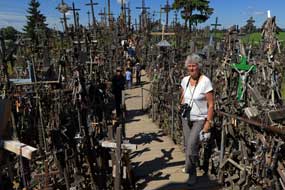 There are as many myths explaining the origins of
the Hill of Crosses as there are crosses covering the Hill. It may have been of
pagan origin associated with ancestor worship, evolving naturally over the
centuries, with Christian crosses replacing pagan totem symbols. The
anti-Tsarist rebellions of 1831 and 1863 and the need to commemorate the fallen
was the factor which turned the Hill into a shrine of There are as many myths explaining the origins of
the Hill of Crosses as there are crosses covering the Hill. It may have been of
pagan origin associated with ancestor worship, evolving naturally over the
centuries, with Christian crosses replacing pagan totem symbols. The
anti-Tsarist rebellions of 1831 and 1863 and the need to commemorate the fallen
was the factor which turned the Hill into a shrine of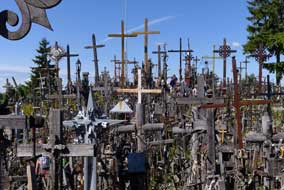 remembrance. The
Lithuanians planted symbolic crosses at this prominent place in the countryside
since the Tsarist authorities would not tolerate such open displays of
nationalistic and Catholic sentiment in an urban setting. The Hill assumed
significance as an expression of Lithuanian national and religious fervour after
all the threats faced throughout the country's troubled history. The need to
demonstrate allegiance to Lithuanian national identity, heritage and Catholic
religion assumed an even greater symbolic importance during the 45 years of
Soviet occupation, despite the planting of crosses being an arrestable offence.
The Hill became a focus of patriotic pilgrimage with people planting their
crosses to commemorate the 1000s executed or deported by the communists.
Determined to eradicate such manifestations of Lithuanian patriotic sentiment
and religious expression, the Soviet authorities repeatedly bulldozed the Hill,
yet overnight more crosses continued to appear as people responded by planting
replacement crosses. By independence in 1991, some 40,000 crosses covered the
Hill and they still go on multiplying. In 1993 Pope John-Paul II celebrated Mass
at the Hill adding further to its prestige as a pilgrimage destination, and of
course remembrance. The
Lithuanians planted symbolic crosses at this prominent place in the countryside
since the Tsarist authorities would not tolerate such open displays of
nationalistic and Catholic sentiment in an urban setting. The Hill assumed
significance as an expression of Lithuanian national and religious fervour after
all the threats faced throughout the country's troubled history. The need to
demonstrate allegiance to Lithuanian national identity, heritage and Catholic
religion assumed an even greater symbolic importance during the 45 years of
Soviet occupation, despite the planting of crosses being an arrestable offence.
The Hill became a focus of patriotic pilgrimage with people planting their
crosses to commemorate the 1000s executed or deported by the communists.
Determined to eradicate such manifestations of Lithuanian patriotic sentiment
and religious expression, the Soviet authorities repeatedly bulldozed the Hill,
yet overnight more crosses continued to appear as people responded by planting
replacement crosses. By independence in 1991, some 40,000 crosses covered the
Hill and they still go on multiplying. In 1993 Pope John-Paul II celebrated Mass
at the Hill adding further to its prestige as a pilgrimage destination, and of
course
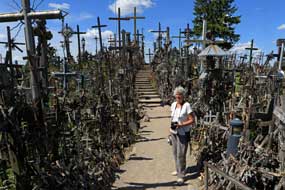 more crosses. The Pope even added his own marble cross inscribed with the
message Thank you Lithuanians for the Hill of Crosses which testifies to the
nations of Europe and the whole world the faith of the people of this land. more crosses. The Pope even added his own marble cross inscribed with the
message Thank you Lithuanians for the Hill of Crosses which testifies to the
nations of Europe and the whole world the faith of the people of this land.
We set off early for our re-visit to the Hill of
Crosses just to the north of Šiauliai, to take advantage of morning sunshine
before the expected cloud and tour buses rolled in. We turned off Route 12 along
the approach lane, where a family of storks nested on a power pole, and even at
10-30am tour buses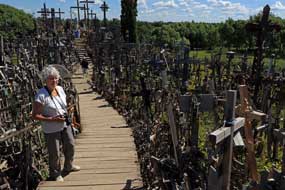 filled the parking area, disgorging their gormless hordes.
Since our 2011 visit, an entire souvenir shop cum tourist complex had been built,
with rows of stalls selling every size of wooden crosses to the tourists. While
this mysteriously inexplicable Catholic fixation with planting crosses at this
otherwise insignificant mound was part of a traditional ritual, for Japanese
tourists to do so simply because it was the done thing encouraged by tour guides
simply belittled the custom and emphasised the commercial exploitation of the
mass tourism industry at its most cynical. filled the parking area, disgorging their gormless hordes.
Since our 2011 visit, an entire souvenir shop cum tourist complex had been built,
with rows of stalls selling every size of wooden crosses to the tourists. While
this mysteriously inexplicable Catholic fixation with planting crosses at this
otherwise insignificant mound was part of a traditional ritual, for Japanese
tourists to do so simply because it was the done thing encouraged by tour guides
simply belittled the custom and emphasised the commercial exploitation of the
mass tourism industry at its most cynical.
The morning was bright as we reached the open area
fronting the Hill, where a towering wooden figure of Christ with arms
outstretched seems to usher pilgrims up onto the pathway which rises amid the
numberless crosses planted by individuals or pilgrim groups (Photo
32- Approach to Hill of Crosses) (see above right), now spreading ever
increasingly sideways from the pathway over the Hill. There were
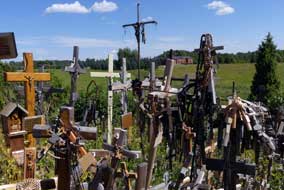 large ornately
carved wooden crosses, metal and plastic crosses, smaller ones simply left
leaning against others, and all hung with 1000s of tiny crucifixes
(Photo
33 - Path over Hill of Crosses). Some crosses
had inscriptions and dedications, or the date of a pilgrimage, others were
tagged with the names or photos of deceased (Photo
34 - Myriads of dedications). Every single one of the crosses
represented an individual act of devotion or personal expression of remembrance (Photo
35 - Crosses and dedications), impossible to imagine
if you large ornately
carved wooden crosses, metal and plastic crosses, smaller ones simply left
leaning against others, and all hung with 1000s of tiny crucifixes
(Photo
33 - Path over Hill of Crosses). Some crosses
had inscriptions and dedications, or the date of a pilgrimage, others were
tagged with the names or photos of deceased (Photo
34 - Myriads of dedications). Every single one of the crosses
represented an individual act of devotion or personal expression of remembrance (Photo
35 - Crosses and dedications), impossible to imagine
if you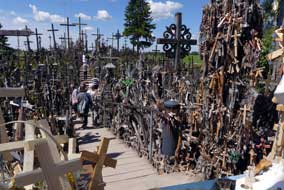 have not witnessed the Hill of Crosses. We walked slowly along the
pathways and side-alleyways over the Hill among the maze of countless myriads of crosses
(Photo
36 - So many crosses), as tourists
blithely stumbled past. As always, we were left wondering why they came, since
generally they showed little interest or understanding of the significance of
this unique Lithuanian institution. We recalled from 2011 that most of the
other visitors then were individual Lithuanians; a Sunday afternoon out with a
difference. In stark contrast today however, the Hill of Crosses has been taken over
merely as an 'attraction' on the tour bus tourist trail, a half-hour stop-off on the
way to 'do' Riga, with overwhelmingly large groups of bored looking tourists simply milling
around aimlessly over the confined pathways of the mound. We heard every language
spoken - French, German, Polish, Japanese, even Latins from South America - but
no Lithuanians. This was the first time in the Baltics that we had encountered
the intrusive presence of mass tourism, after suffering with it
every day last year in Iceland. As late morning approached, the tour buses have not witnessed the Hill of Crosses. We walked slowly along the
pathways and side-alleyways over the Hill among the maze of countless myriads of crosses
(Photo
36 - So many crosses), as tourists
blithely stumbled past. As always, we were left wondering why they came, since
generally they showed little interest or understanding of the significance of
this unique Lithuanian institution. We recalled from 2011 that most of the
other visitors then were individual Lithuanians; a Sunday afternoon out with a
difference. In stark contrast today however, the Hill of Crosses has been taken over
merely as an 'attraction' on the tour bus tourist trail, a half-hour stop-off on the
way to 'do' Riga, with overwhelmingly large groups of bored looking tourists simply milling
around aimlessly over the confined pathways of the mound. We heard every language
spoken - French, German, Polish, Japanese, even Latins from South America - but
no Lithuanians. This was the first time in the Baltics that we had encountered
the intrusive presence of mass tourism, after suffering with it
every day last year in Iceland. As late morning approached, the tour buses
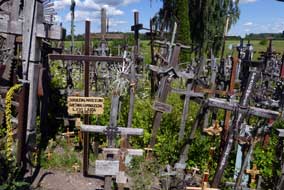 were
rolling in with a relentless vengeance. It was now simply impossible to
appreciate the Hill of Crosses' peaceful ambience, as the seemingly endless procession of mindless intruders
indifferently pushed and shoved their way over the pathways, showing no respect
and treading on crosses as they scrambled to take their 'selfies'. It was a
sickeningly depressing experience, as we waded through the masses of tourists
swarming from their tour buses, yet another unique institution sacrificed to the
inexorable were
rolling in with a relentless vengeance. It was now simply impossible to
appreciate the Hill of Crosses' peaceful ambience, as the seemingly endless procession of mindless intruders
indifferently pushed and shoved their way over the pathways, showing no respect
and treading on crosses as they scrambled to take their 'selfies'. It was a
sickeningly depressing experience, as we waded through the masses of tourists
swarming from their tour buses, yet another unique institution sacrificed to the
inexorable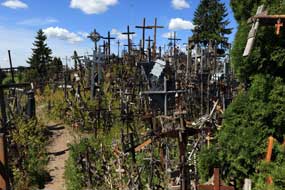 greed of the mass tourism industry. greed of the mass tourism industry.
Before returning to camp at Gražina, we drove down
into Šiauliai to shop for supplies at a Maxima supermarket buried away in the
gloomy depths of a shopping complex. As forecast. the clear sun of morning was
replaced with full cloud cover as we settled back in at the campsite for an
afternoon's writing. It had been a successful morning of photography at the Hill
of Crosses, despite the mass tourist invasion now bedevilling this curiously
unique place. Tomorrow we continue westwards for our final days in Lithuania at Žemaitija
National Park.
Žemaitija National Park:
from Šiauliai we made good progress westwards on Route A11 highway past the
small town of Kuršėai (click
here for detailed map of route). Beyond Telšiai, we turned off onto
minor roads into Žemaitija National Park, reaching the settlement of Paplatėlė
on the NE shore of Lake Žemaitija to investigate potential camp spots. The best
of a poor lot was Paežerė Camping, a very basic site used in 2011 despite it
then
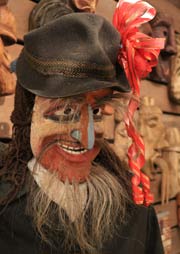 being overcrowded with noisy Lithuanian holiday-makers. Today it was almost
deserted; facilities were primitive and limited to one very smelly earth privvie
and no shower or wash-up. Unless we could find somewhere else, this was going to
have to serve. We continued around the head of the lake into Plateliai village
for the being overcrowded with noisy Lithuanian holiday-makers. Today it was almost
deserted; facilities were primitive and limited to one very smelly earth privvie
and no shower or wash-up. Unless we could find somewhere else, this was going to
have to serve. We continued around the head of the lake into Plateliai village
for the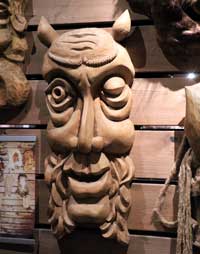 National Park Information Office. Here the very helpful lady in fluent
English gave us details of various walking routes and of the National Park's
other curiosity, the former Soviet missile base at Plokštinė. National Park Information Office. Here the very helpful lady in fluent
English gave us details of various walking routes and of the National Park's
other curiosity, the former Soviet missile base at Plokštinė.
Plateliai Ethnographical Museum:
the village of Plateliai is noted for its carved
wooden folk art, seen outside cottages and on wayside shrines, but the
ethnographic museum in the village displays curious items from a particularly
unusual local custom. The Plateliai Shrove Tuesday day and night-long
celebrations, the Užgavėnės, entail masked revels and dancing with a
procession of decorated carts or sledges (photographs showed that snow is often
still on the ground). The
similarities of such revels to other masked traditional Spring-tide renewal
festivals throughout Europe such as Mardi Gras or Carnevale was uncanny. There
was clear commonality with Spring renewal and fertility ceremonies all across
Europe, with anonymity of participants assured by masks or blacking of faces (cf
English Morris Dancing) to assure the ceremonies' magic. Such animalistic Springtime renewal celebrations must go back into
the mists of time, but this one at Plateliai is still very much alive and
kicking, taking place every Shrove Tuesday. The Plateliai Ethnographical Museum
displays the carved wooden masks still used in the Shrove Tuesday revels, many
entailing goat-like horned demon devilish figures
(Photo
37 - Shrove Tuesday festival masks) (see left and right). We had seen similar carved wooden masks
used in village carnivals in Sardinia with the same exaggerated hooked nose.
Masks are made anew each year, so that according to tradition wearers cannot be
recognised. The procession goes from house to house to be rewarded with gifts of
pancakes or money; singing, music, dancing and much revelry culminate at
the bonfire on which the effigy of a grotesquely costumed old lady, the Morė
representing winter, is burnt. How long ago was it, we wondered, when such
pre-Christian traditional
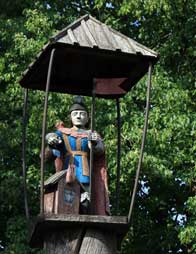 Springtime renewal festivals entailed purging the
community of ill-fortune (driving out the devil in Christian parlance) by the
burning-sacrifice of a live old woman under the pretext of her being a witch.
Two of the festival characters, the fat Lašininis (Porky) and lean
Kanapinis (Hemp Man), perform a staged battle in what resembles a Mummers'
play, personifying the defeat of Winter by the incoming Spring
(Photo
38 - Winter & Spring characters). The museum curator showed us the display of
masks and told us more about the annual Shrove Tuesday festival at Plateliai. Springtime renewal festivals entailed purging the
community of ill-fortune (driving out the devil in Christian parlance) by the
burning-sacrifice of a live old woman under the pretext of her being a witch.
Two of the festival characters, the fat Lašininis (Porky) and lean
Kanapinis (Hemp Man), perform a staged battle in what resembles a Mummers'
play, personifying the defeat of Winter by the incoming Spring
(Photo
38 - Winter & Spring characters). The museum curator showed us the display of
masks and told us more about the annual Shrove Tuesday festival at Plateliai.
Back through Plateliai village we found another
traditional Lithuanian carved wooden folk-art wayside shrine incorporating the
figure of the Sorrowful Christ, the Rūpintojėlis, by the church
(Photo
39 - Rūpintojėlis Sorrowful Christ), and another piece of folk-art, a colourful
carved figure of St Florian, the patron saint of fire fighters so important in
communities where wooden cottages are the norm; this figure portrayed the blessed
St Florian dousing the flames of a burning wooden cottage with water from his
bucket (see left). Having identified no other camp site, we were obliged to
return to Paplatėlė, and part way around the lake we paused by a
Žemaitija farmstead
(Photo
40 - Žemaitija farmstead) to photograph a stork nesting on the farm's
power-pole
(see right)
(Photo
41 - Nesting stork). In Northern European stork country, people
regularly erect platforms on power-poles, roof tops and chimneys to encourage
storks build their nests for the luck that they are thought to bring.
Paežere Camping by Lake Platelių:
the elderly lady owner greeted us at the campsite gates, gabbling away in a
mixture of Lithuanian and German; the more we indicated non-comprehension, the
faster she gabbled! Although the site's facilities were basic in the extreme,
the setting in a lakeside pine forest clearing was pleasant and at least it was
peaceful at present
(Photo
42 - Paežere Camping) (see below left and right). We were unsure however
about a second night here on a Friday with forecast of a sunny weekend and Paežere likely to fill
with rowdy holiday-makers.
 Former
Soviet Cold War missile silo site at Plokštinė: Žemaitija has another unique and chilling feature: it's the only National Park we know of that includes a former Soviet
missile silo base. Here, hidden away in the forests of Plokštinė, the Soviet army built one of the first rocket launching sites
in the USSR. At Former
Soviet Cold War missile silo site at Plokštinė: Žemaitija has another unique and chilling feature: it's the only National Park we know of that includes a former Soviet
missile silo base. Here, hidden away in the forests of Plokštinė, the Soviet army built one of the first rocket launching sites
in the USSR. At a time of the Cold War arms race in the late 1950s, when the USA
was building underground missile bases targeted at USSR, the Soviets countered
with a silo construction programme of their own to keep pace. Work on building
the missile base at Plokštinė was begun in 1960 in maximum security in
these remote forests of NE Lithuania in territory occupied by the then USSR
bordering onto Western Europe. At 160m above sea level, the area was higher than
most of the Baltic region and sparsely populated; several farms were moved to
evacuate the site totally. 10,000 Red Army troops dug four 34m deep 8m wide missile
silo pits in the sandy soil by manual labour at the outer corners of the site;
each of the 4 steel-lined missile silos was covered by a concrete dome that
could be moved aside on rails, each connected by underground communications
tunnels to a central command and control centre. The entire underground complex
could be hermetically sealed off, with the crews able to survive for 2 weeks in
the event of nuclear attack. Like something out of a James Bond film, the only
part of the missile-launching site visible from above were the domed lids of the
4 silos. Four Soviet R12 Dvina ballistic missiles (known to NATO as SS4s) were
deployed at Plokštinė during the Cold War, lowered by crane into the silos;
each was equipped with a megaton thermonuclear warhead a time of the Cold War arms race in the late 1950s, when the USA
was building underground missile bases targeted at USSR, the Soviets countered
with a silo construction programme of their own to keep pace. Work on building
the missile base at Plokštinė was begun in 1960 in maximum security in
these remote forests of NE Lithuania in territory occupied by the then USSR
bordering onto Western Europe. At 160m above sea level, the area was higher than
most of the Baltic region and sparsely populated; several farms were moved to
evacuate the site totally. 10,000 Red Army troops dug four 34m deep 8m wide missile
silo pits in the sandy soil by manual labour at the outer corners of the site;
each of the 4 steel-lined missile silos was covered by a concrete dome that
could be moved aside on rails, each connected by underground communications
tunnels to a central command and control centre. The entire underground complex
could be hermetically sealed off, with the crews able to survive for 2 weeks in
the event of nuclear attack. Like something out of a James Bond film, the only
part of the missile-launching site visible from above were the domed lids of the
4 silos. Four Soviet R12 Dvina ballistic missiles (known to NATO as SS4s) were
deployed at Plokštinė during the Cold War, lowered by crane into the silos;
each was equipped with a megaton thermonuclear warhead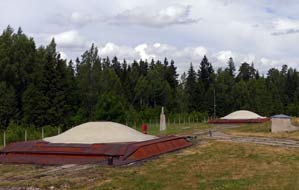 . Other missiles were
based nearby at Šateikiai along with a bunker for storing the nuclear warheads.
The R12 ballistic missile was 23m high including the 4m warhead; the rocket was
liquid fuelled by a mixture of kerosene and nitric acid, and weighed 40 tons
including the 1,500 Kgm warhead. They had a range of 2,000kms and were targeted at Western European
NATO countries such as UK, Norway, West Germany and Turkey. Missiles from Plokštinė
were transported by train to Black Sea ports in 1962 and shipped by . Other missiles were
based nearby at Šateikiai along with a bunker for storing the nuclear warheads.
The R12 ballistic missile was 23m high including the 4m warhead; the rocket was
liquid fuelled by a mixture of kerosene and nitric acid, and weighed 40 tons
including the 1,500 Kgm warhead. They had a range of 2,000kms and were targeted at Western European
NATO countries such as UK, Norway, West Germany and Turkey. Missiles from Plokštinė
were transported by train to Black Sea ports in 1962 and shipped by Khrushchev
to Havana, where troops from Plokštinė built the missile bases which sparked the Cuban Missile
Crisis bringing the world to the brink of nuclear war. The Plokštinė silo
complex was completed in 1962, armed with its R12 missiles and remained
operational until 1978, surrounded by sophisticated security enclosure and ready
to fire its missiles if the orders were received from Moscow. In fact during
this time, no missile was ever launched from Plokštinė even for tests, and
the missile base remained unknown to US/NATO intelligence until 1978. As rocket
technology developed with increased range, the Plokštinė base was
mysteriously closed in 1978; the Soviets withdrew their nuclear ballistic
missiles deeper into the USSR, and the base abandoned. It was plundered by metal
thieves who looted all but the biggest pieces of equipment, and the site lay
derelict for 2 decades. Khrushchev
to Havana, where troops from Plokštinė built the missile bases which sparked the Cuban Missile
Crisis bringing the world to the brink of nuclear war. The Plokštinė silo
complex was completed in 1962, armed with its R12 missiles and remained
operational until 1978, surrounded by sophisticated security enclosure and ready
to fire its missiles if the orders were received from Moscow. In fact during
this time, no missile was ever launched from Plokštinė even for tests, and
the missile base remained unknown to US/NATO intelligence until 1978. As rocket
technology developed with increased range, the Plokštinė base was
mysteriously closed in 1978; the Soviets withdrew their nuclear ballistic
missiles deeper into the USSR, and the base abandoned. It was plundered by metal
thieves who looted all but the biggest pieces of equipment, and the site lay
derelict for 2 decades.
After independence in 1991, when the heritage
value of the site was realised, the
Lithuanians opened what remained of the former missile launching site under the
name of the Plokštinė Militarism Exhibition, with visitors escorted
underground to peer down into the malevolent silos from a
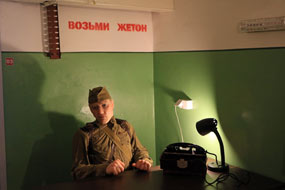 maintenance gallery.
But age and decay had taken their toll and the subterranean galleries became so
dangerous that they had either to be closed or refurbished; EU monies were
secured for restoration. We had managed to reach the site in 2011 during the
period of closure for refurbishment, but had only been able to view the domed
silo lids from the barbed-wire fence. In the intervening time, Plokštinė
had maintenance gallery.
But age and decay had taken their toll and the subterranean galleries became so
dangerous that they had either to be closed or refurbished; EU monies were
secured for restoration. We had managed to reach the site in 2011 during the
period of closure for refurbishment, but had only been able to view the domed
silo lids from the barbed-wire fence. In the intervening time, Plokštinė
had
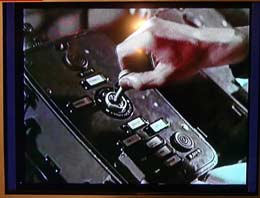 re-opened as the Cold War Museum, and our plan for today was to visit the
former Soviet underground missile silo complex, hidden away in the depths of the
forests just 3kms from where we were camped at Paplatėlė. re-opened as the Cold War Museum, and our plan for today was to visit the
former Soviet underground missile silo complex, hidden away in the depths of the
forests just 3kms from where we were camped at Paplatėlė.
The Cold War Museum at Plokštinė: we
had been told by the National Park Office of a shorter access route to Plokštinė
from the campsite at Paplatėlė on the eastern side of the lake, but maps showed little
more than a uncertain forestry road. We had tried to follow this lane in 2011
but failed to get through; today we ventured hesitantly beyond where the tarmac
ended by a sign pointed to the Cold War Museum (Šaltojo Karo Muziejus);
not even the sat nav map knew of the road, but we managed to follow the
sand-surfaced lane through the forest and in 3kms reached the Plokštinė
parking area by the former missile site. Equipped with audio-guides, we passed
through what was once the electrified security fence gates to approach the
museum based in the silos' underground control centre. A viewing tower
gave an overview of the site, and above ground the most evident features were
the ominous bulging domed concrete lids of the four missile silos with their
rusting steel
 surrounds and rails on which the cover assembly (no longer
functioning) could be moved back for missile launching (Photo
43 - Plokštinė Soviet missile silos) (see above left). At ground level, there was little other
evidence of the 2 storey underground command and communications centre other
than the bulge of its turfed and reinforced concrete protective cover. We
climbed up onto this to photograph the bulging domed lids of the missile silos
and their now rusting withdrawal mechanism (Photo
44 - Missile silo domed lid) (see above right), before finding the entrance stairway down into the
underground command complex at the centre of the surrounding 4 silos. surrounds and rails on which the cover assembly (no longer
functioning) could be moved back for missile launching (Photo
43 - Plokštinė Soviet missile silos) (see above left). At ground level, there was little other
evidence of the 2 storey underground command and communications centre other
than the bulge of its turfed and reinforced concrete protective cover. We
climbed up onto this to photograph the bulging domed lids of the missile silos
and their now rusting withdrawal mechanism (Photo
44 - Missile silo domed lid) (see above right), before finding the entrance stairway down into the
underground command complex at the centre of the surrounding 4 silos.
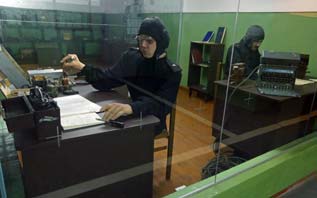 At the foot of the stairs, we faced a mannequin
guard sat by a desk telephone (see above left), before entering the airtight, nuclear
attack-proof steel sealing door of the complex. The empty chambers of the
command centre are now set out with the museum's well-documented displays relating
the post-war history of missile development and Cold War arms race, which
culminated with the signing by Gorbachev and Regan of the nuclear arms reduction
treaties in the late 1980s (see right). This 1987 Intermediate Range Nuclear Forces (INF)
Treaty banned all ground-launched medium range (500~5,500 kms) missiles. BBC News
reports that Trump now threatens to withdraw from this Treaty, insisting that Putin has
already breached it by deployment of SSC-4 cruise missiles. Displays in the
museum also showed the workings of the Plokštinė
missile site, and constant state of readiness to launch its missiles at UK and
Western Europe given the signal from Moscow (see below left). The displays included archive film
of R12 missiles being lowered into the silos At the foot of the stairs, we faced a mannequin
guard sat by a desk telephone (see above left), before entering the airtight, nuclear
attack-proof steel sealing door of the complex. The empty chambers of the
command centre are now set out with the museum's well-documented displays relating
the post-war history of missile development and Cold War arms race, which
culminated with the signing by Gorbachev and Regan of the nuclear arms reduction
treaties in the late 1980s (see right). This 1987 Intermediate Range Nuclear Forces (INF)
Treaty banned all ground-launched medium range (500~5,500 kms) missiles. BBC News
reports that Trump now threatens to withdraw from this Treaty, insisting that Putin has
already breached it by deployment of SSC-4 cruise missiles. Displays in the
museum also showed the workings of the Plokštinė
missile site, and constant state of readiness to launch its missiles at UK and
Western Europe given the signal from Moscow (see below left). The displays included archive film
of R12 missiles being lowered into the silos
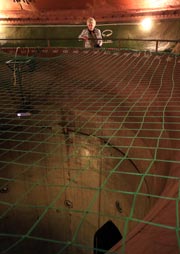 and being armed with the nuclear
warhead atop the rocket, followed by the launch sequence; a display case showed
one of the actual keys required to launch the missiles (see above left and
right). The gloomy lower level
still contained what remained of the rockets' liquid fuel storage together with
the base's diesel generators after metal thieves had stripped everything
removable, and along eerily empty corridors holes in partition walls showed where ducting and
cables once ran. From one corner of the lower level, a tunnel led off to an
access door into the top chamber of one of the missile silos. Part-way along,
another mannequin stood eerily dressed in the rubberised protective suit and
gas-mask for fuelling the rockets with their highly and being armed with the nuclear
warhead atop the rocket, followed by the launch sequence; a display case showed
one of the actual keys required to launch the missiles (see above left and
right). The gloomy lower level
still contained what remained of the rockets' liquid fuel storage together with
the base's diesel generators after metal thieves had stripped everything
removable, and along eerily empty corridors holes in partition walls showed where ducting and
cables once ran. From one corner of the lower level, a tunnel led off to an
access door into the top chamber of one of the missile silos. Part-way along,
another mannequin stood eerily dressed in the rubberised protective suit and
gas-mask for fuelling the rockets with their highly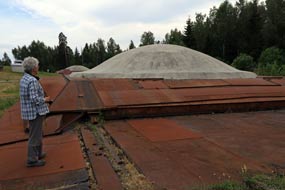 toxic nitric acid. A further
access port had been cut through the silo's concrete upper wall and its thick
steel lining to enable visitors now to stand around the top of the 34m deep
launch silo and to peer down into its murky depths. The climax of the visit was
the eeriest part of the entire spine-chilling experience, gazing down into the now
empty and dimly lit silo pit, with its access ports at lower levels where crews
would have fuelled and calibrated the missile ready for launch (see left)(Photo
45 - Missile silo pit interior); and up above, the massive steel silo lid and
withdrawal mechanism with its domed concrete cover seen from outside. It was a
terrifying thought that for more than 15 years during the 1960s and 70s, this
silo pit had been occupied by a missile armed with a megaton thermonuclear
warhead, ready to fire a moment's notice, and targeted at us in UK. It was a
relief to emerge from the ominous semi-darkness of this missile chamber of death
into daylight, albeit alongside the rusting steel removal mechanism of the silo's domed
concrete cover
(Photo
46 - Silo superstructure) (see right). Cloud had now gathered adding to the gloom of this chilling
setting amid the surrounding pine forests. The roadway led around to where,
hidden away in the forest, we came upon the former nuclear warhead storage
bunker now deserted and all locked up. The empty yard in front would make a
bizarre wild-camp spot if we needed it for tonight - another first, camping right next to a
former Soviet nuclear warhead
storage bunker (see below left). toxic nitric acid. A further
access port had been cut through the silo's concrete upper wall and its thick
steel lining to enable visitors now to stand around the top of the 34m deep
launch silo and to peer down into its murky depths. The climax of the visit was
the eeriest part of the entire spine-chilling experience, gazing down into the now
empty and dimly lit silo pit, with its access ports at lower levels where crews
would have fuelled and calibrated the missile ready for launch (see left)(Photo
45 - Missile silo pit interior); and up above, the massive steel silo lid and
withdrawal mechanism with its domed concrete cover seen from outside. It was a
terrifying thought that for more than 15 years during the 1960s and 70s, this
silo pit had been occupied by a missile armed with a megaton thermonuclear
warhead, ready to fire a moment's notice, and targeted at us in UK. It was a
relief to emerge from the ominous semi-darkness of this missile chamber of death
into daylight, albeit alongside the rusting steel removal mechanism of the silo's domed
concrete cover
(Photo
46 - Silo superstructure) (see right). Cloud had now gathered adding to the gloom of this chilling
setting amid the surrounding pine forests. The roadway led around to where,
hidden away in the forest, we came upon the former nuclear warhead storage
bunker now deserted and all locked up. The empty yard in front would make a
bizarre wild-camp spot if we needed it for tonight - another first, camping right next to a
former Soviet nuclear warhead
storage bunker (see below left).
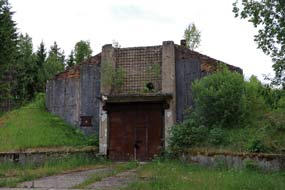 The
Šeirė footpath alongside Lake Platelių:
we returned around the sandy lane past the still quiet Paežere Camping (perhaps
we should not need the nuclear warhead bunker wild-camp tonight!) and drove back
to Plateliai village and the parking area to walk the Šeirė lake-side path. We
had The
Šeirė footpath alongside Lake Platelių:
we returned around the sandy lane past the still quiet Paežere Camping (perhaps
we should not need the nuclear warhead bunker wild-camp tonight!) and drove back
to Plateliai village and the parking area to walk the Šeirė lake-side path. We
had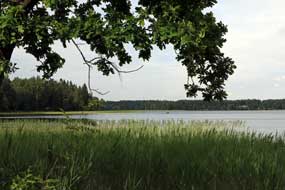 walked this 3km circuit alongside Lake Platelių in 2011, getting memorable
photos then of dappled pink cloudscape reflected in the still waters of the
lake. Today however with the lake ruffled, light dull and a gloomy veil of cloud
cover, photographic potential was poor (see right). The path crossed the
reed-covered Gaudupis marshland on a foot-bridge and alongside the lake, turning
uphill into the forest close to Piktežeris lake, and zigzagging back to re-cross
Gaudupis where several species of orchids grew in the marshland. Back around to Paplatėlė
on the eastern side of the lake, we settled back into Paežere Camping after a
long and interesting day. After supper we again walked down to the lake-shore
for sunset photos looking across Lake Platelių through the lakeside reeds (Photo
47 - Sunset across Lake Platelių) (see below left). A lone
fisherman rowed through the shallows, his boat catching the golden light of the
setting sun (see below right).
walked this 3km circuit alongside Lake Platelių in 2011, getting memorable
photos then of dappled pink cloudscape reflected in the still waters of the
lake. Today however with the lake ruffled, light dull and a gloomy veil of cloud
cover, photographic potential was poor (see right). The path crossed the
reed-covered Gaudupis marshland on a foot-bridge and alongside the lake, turning
uphill into the forest close to Piktežeris lake, and zigzagging back to re-cross
Gaudupis where several species of orchids grew in the marshland. Back around to Paplatėlė
on the eastern side of the lake, we settled back into Paežere Camping after a
long and interesting day. After supper we again walked down to the lake-shore
for sunset photos looking across Lake Platelių through the lakeside reeds (Photo
47 - Sunset across Lake Platelių) (see below left). A lone
fisherman rowed through the shallows, his boat catching the golden light of the
setting sun (see below right).
Westwards
back to the Baltic coast at Palanga: our final day in Lithuania after 5
good weeks of travelling around the first of the Baltic States.
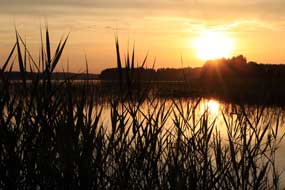 Today we should
head west to Palanga on the Baltic coast before crossing into Latvia later. As
we completed our morning jobs and packing this morning, the weekenders began
arriving with loud, throbbing car radios; how thankful we were to be leaving. Back
around to Plateliai, we continued past Today we should
head west to Palanga on the Baltic coast before crossing into Latvia later. As
we completed our morning jobs and packing this morning, the weekenders began
arriving with loud, throbbing car radios; how thankful we were to be leaving. Back
around to Plateliai, we continued past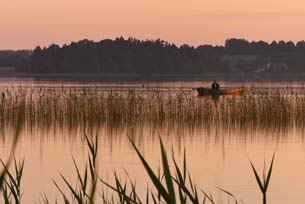 the tail end of Lake Platelių to
join Route 54 down to Plungė. Here we turned westwards on the main A11 in bright
morning sunshine through some of the most intensively farmed agricultural land
seen in Lithuania (click
here for detailed map of route), again constantly overtaken by
recklessly speeding Lithuanian drivers. At Kartena, the road crossed the Minija
River which meanders a snaking course parallel with the Baltic coast just a few
kms inland to outflow into the Nemunas by the Curonian Lagoon at Rusnė where we
had been seemingly so long ago. Through Kretinga, still plagued by major
roadworks as in 2011, we eventually reached the outskirts of Palanga in
congested traffic, and worked our way through the town for a passing visit to
the Amber Museum set in coastal forest parkland in the southern part of
the town. the tail end of Lake Platelių to
join Route 54 down to Plungė. Here we turned westwards on the main A11 in bright
morning sunshine through some of the most intensively farmed agricultural land
seen in Lithuania (click
here for detailed map of route), again constantly overtaken by
recklessly speeding Lithuanian drivers. At Kartena, the road crossed the Minija
River which meanders a snaking course parallel with the Baltic coast just a few
kms inland to outflow into the Nemunas by the Curonian Lagoon at Rusnė where we
had been seemingly so long ago. Through Kretinga, still plagued by major
roadworks as in 2011, we eventually reached the outskirts of Palanga in
congested traffic, and worked our way through the town for a passing visit to
the Amber Museum set in coastal forest parkland in the southern part of
the town.
The Palanga Amber Museum:
all possible street parking places were taken up by locals thronging to the
Baltic beaches on a sunny Saturday afternoon, but by good chance we happened
upon one remaining space alongside the coastal pine forests,
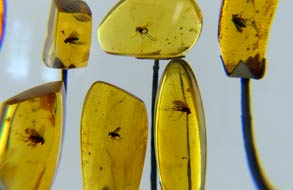 leaving us a 1.5km
walk back to reach the Amber Museum. We soon found a delightful route leading to
the museum through the forest and parkland gardens formally laid out in the late
19th century around the mansion built by Count Felix Tiškevičius which now houses the Palanga Amber Museum. The Museum is a branch of the Lithuanian Art
Museum, and gives details background on amber formation from fossilized pine
resin 50 million years ago on the then Fenno-Scandic landmass, conserved in later
sea leaving us a 1.5km
walk back to reach the Amber Museum. We soon found a delightful route leading to
the museum through the forest and parkland gardens formally laid out in the late
19th century around the mansion built by Count Felix Tiškevičius which now houses the Palanga Amber Museum. The Museum is a branch of the Lithuanian Art
Museum, and gives details background on amber formation from fossilized pine
resin 50 million years ago on the then Fenno-Scandic landmass, conserved in later
sea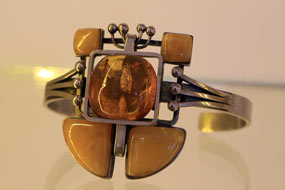 bed alluvium, and washed up on the shore of the Baltic Sea. Admission was a
very reasonable €1.50 senior's concession, and along with this detailed
background on amber formation, the museum displayed huge specimens of raw amber,
as well as extensive examples of amber inclusions where plant fragments and
insects were trapped in the pine resin and preserved in the amber which resulted
from its fossilization, giving credence to the Jurassic Park dinosaur DNA yarn (Photo
48 - Amber inclusion) (see left). Displays showed amber ornaments, artefacts and
jewellery from Neolithic sites in the Middle East; ancient Baltic tribes had
been at the supply end of trade routes in amber, trading amber for goods and
metals imported from the Mediterranean, Near and Middle East. Further displays
gave ornate examples of amber jewellery manufactured in Palanga's amber
workshops from the 19th century, with amber mined on an industrial scale along
the Baltic coast and Curonian Spit. bed alluvium, and washed up on the shore of the Baltic Sea. Admission was a
very reasonable €1.50 senior's concession, and along with this detailed
background on amber formation, the museum displayed huge specimens of raw amber,
as well as extensive examples of amber inclusions where plant fragments and
insects were trapped in the pine resin and preserved in the amber which resulted
from its fossilization, giving credence to the Jurassic Park dinosaur DNA yarn (Photo
48 - Amber inclusion) (see left). Displays showed amber ornaments, artefacts and
jewellery from Neolithic sites in the Middle East; ancient Baltic tribes had
been at the supply end of trade routes in amber, trading amber for goods and
metals imported from the Mediterranean, Near and Middle East. Further displays
gave ornate examples of amber jewellery manufactured in Palanga's amber
workshops from the 19th century, with amber mined on an industrial scale along
the Baltic coast and Curonian Spit.
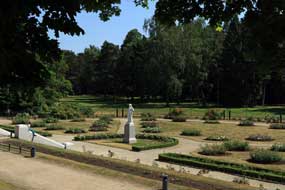 The Palanga Amber Museum had been a
worthwhile and good value visit; we had learned much about amber formation and
its significance in Baltic trade. The Palanga Amber Museum had been a
worthwhile and good value visit; we had learned much about amber formation and
its significance in Baltic trade.
Towards the
Latvian border: a pleasant
stroll through the parkland gardens (see left) back to George, and it was now
time to make our way through busy traffic and chaos of roadworks to shop for
provisions, before leaving Palanga and re-joining A13 heading northwards through
the coastal pine forests towards the Latvian border. We had driven some 1,500
miles around Lithuania over the last 5 weeks, met many interesting
people, learned much about the country, and gained a fascinating variety of
experiences as this edition shows. It was now time to cross into our
second Baltic republic, Latvia, but that's the story for the next edition which
will follow shortly.
Next edition
from Latvia to be published quite soon
|
Sheila and Paul |
Published: 23 October 2018 |
|

 A
Hanseatic Tour of the Baltic 2018 -
North-east and North-west Lithuania:
A
Hanseatic Tour of the Baltic 2018 -
North-east and North-west Lithuania: historical
sites (click on Map 1 right for our route). Set in the valley of the meandering Neris River, with ample fresh water
from tributary streams, plentiful food supplies, fertile soil for agriculture
and grazing, and 5 flat-topped hillocks above the valley bottom for protection
in times of threat, the site at Kernavė had been occupied continuously
since the late Palaeolithic 9th millennium BC. The Neris valley had been created
among moraine hills by Ice Age glacial melt-water, with side streams forming
gullies in the alluvium with intervening promontories forming hillocks which
later settlers levelled and fortified with wooden stockade hill-forts for
protection in troubled times. Soon after the retreat of the glaciers, migrant
hunter-gatherers initially set up temporary encampments in the Neris valley
hunting grounds, as evidenced by arrow-heads and other flint artefacts unearthed
at Kernavė from this period.
historical
sites (click on Map 1 right for our route). Set in the valley of the meandering Neris River, with ample fresh water
from tributary streams, plentiful food supplies, fertile soil for agriculture
and grazing, and 5 flat-topped hillocks above the valley bottom for protection
in times of threat, the site at Kernavė had been occupied continuously
since the late Palaeolithic 9th millennium BC. The Neris valley had been created
among moraine hills by Ice Age glacial melt-water, with side streams forming
gullies in the alluvium with intervening promontories forming hillocks which
later settlers levelled and fortified with wooden stockade hill-forts for
protection in troubled times. Soon after the retreat of the glaciers, migrant
hunter-gatherers initially set up temporary encampments in the Neris valley
hunting grounds, as evidenced by arrow-heads and other flint artefacts unearthed
at Kernavė from this period.  As the climate warmed and the valley became
forested, and with the domestication of plants and animals, the Kernavė
site was settled by Neolithic pastoralists during the 5th~3rd millennia BC. New
waves of migrants of Indo-European origins later settled the area, and during
the early metal age from the 2nd~1st millennia BC, bronze and iron implements
were forged by settlers at Kernavė. Into the early centuries of the Common
Era, the development of metallurgy and widespread use of iron working led to
increased productivity of foodstuffs, improvement in living conditions and
growth in population in the Neris valley by peoples considered ancestors of the
Baltic tribes. The first fortifications were built on the hillocks above the
Pajauta valley at Kernavė by the 3rd~4th centuries AD. Archaeological finds,
including a silver denarius of Marcus Aurelius dated to 161~2 AD showed that trade
developed with the Roman Province of Germania. Further migrations into the
region in the 5~6th centuries AD led to the divergence of the Balts into
distinctive tribes, with the direct ancestors of the Lithuanian people occupying
the tribal centre at Kernavė. The fortification of the Kernavė
hill-forts and prosperity of the township during the 11~13t
As the climate warmed and the valley became
forested, and with the domestication of plants and animals, the Kernavė
site was settled by Neolithic pastoralists during the 5th~3rd millennia BC. New
waves of migrants of Indo-European origins later settled the area, and during
the early metal age from the 2nd~1st millennia BC, bronze and iron implements
were forged by settlers at Kernavė. Into the early centuries of the Common
Era, the development of metallurgy and widespread use of iron working led to
increased productivity of foodstuffs, improvement in living conditions and
growth in population in the Neris valley by peoples considered ancestors of the
Baltic tribes. The first fortifications were built on the hillocks above the
Pajauta valley at Kernavė by the 3rd~4th centuries AD. Archaeological finds,
including a silver denarius of Marcus Aurelius dated to 161~2 AD showed that trade
developed with the Roman Province of Germania. Further migrations into the
region in the 5~6th centuries AD led to the divergence of the Balts into
distinctive tribes, with the direct ancestors of the Lithuanian people occupying
the tribal centre at Kernavė. The fortification of the Kernavė
hill-forts and prosperity of the township during the 11~13t h centuries led to the
consolidation of the Lithuanian Balts into a distinct nation-state during the
reign of Grand Duke Mindaugas (1236~63). Under Grand Duke Traidenis (1269~82), Kernavė
became one of the most important economic and political centres of the Grand
Duchy of Lithuania, with the Duke's residence
h centuries led to the
consolidation of the Lithuanian Balts into a distinct nation-state during the
reign of Grand Duke Mindaugas (1236~63). Under Grand Duke Traidenis (1269~82), Kernavė
became one of the most important economic and political centres of the Grand
Duchy of Lithuania, with the Duke's residence
 occupying the central hill-fort of Akuras Hill, protected by a defensive system of forts on the surrounding hills.
A township of merchants and craftsmen developed in the Pajauta Valley on the
river's upper terrace at the foot of the hills. This was the period of the
Lithuanian Baltic tribes' conversion from paganism to Christianity. At the
beginning of the 14th century, Grand Duke Gediminas transferred the tribal
centre from Kernavė to Trakai and later to Vilnius. Kernavė continued
for some time as an important economic centre until attacks by the Teutonic
Knights (so-called Crusaders) finally resulted in Kernavė's destruction in
1390. The occupants deserted the settlement in the Pajauta Valley, and the site
was never again occupied. Alluvial deposits from the Neris covered the site and
medieval township, preserving it to be rediscovered by archaeologists in the
20th century.
occupying the central hill-fort of Akuras Hill, protected by a defensive system of forts on the surrounding hills.
A township of merchants and craftsmen developed in the Pajauta Valley on the
river's upper terrace at the foot of the hills. This was the period of the
Lithuanian Baltic tribes' conversion from paganism to Christianity. At the
beginning of the 14th century, Grand Duke Gediminas transferred the tribal
centre from Kernavė to Trakai and later to Vilnius. Kernavė continued
for some time as an important economic centre until attacks by the Teutonic
Knights (so-called Crusaders) finally resulted in Kernavė's destruction in
1390. The occupants deserted the settlement in the Pajauta Valley, and the site
was never again occupied. Alluvial deposits from the Neris covered the site and
medieval township, preserving it to be rediscovered by archaeologists in the
20th century. Chronicle and Hermanni de Watberge Chronicon Livoniae,
describing the Teutonic Order's 1279 raid into the Lithuanian realm as far as Kernavė.
Archaeological excavations by Vilnius University began in 1979, producing a
treasure trove of artefacts and grave goods spanning the 11 millennia of the Kernavė
site's occupation until the medieval township's destruction in 1390. These are
now displayed in the Kernavė Archaeological Museum, leading to Kernavė
being dubbed the Troy of Lithuania.
Chronicle and Hermanni de Watberge Chronicon Livoniae,
describing the Teutonic Order's 1279 raid into the Lithuanian realm as far as Kernavė.
Archaeological excavations by Vilnius University began in 1979, producing a
treasure trove of artefacts and grave goods spanning the 11 millennia of the Kernavė
site's occupation until the medieval township's destruction in 1390. These are
now displayed in the Kernavė Archaeological Museum, leading to Kernavė
being dubbed the Troy of Lithuania.
 valley beyond. Wooden step-ways led up onto
each of the steep-sided hill-fort sites,
and we climbed Castle Hill with its extensive flat-top site of the Grand Duke's
former residence, and the more narrow Mindaugas Hill. From both these
flat-topped hillocks views opened out of the other hill-forts, the narrow
winding Pajauta valley between them and the wide river terrace beyond, site of
the medieval township (
valley beyond. Wooden step-ways led up onto
each of the steep-sided hill-fort sites,
and we climbed Castle Hill with its extensive flat-top site of the Grand Duke's
former residence, and the more narrow Mindaugas Hill. From both these
flat-topped hillocks views opened out of the other hill-forts, the narrow
winding Pajauta valley between them and the wide river terrace beyond, site of
the medieval township ( evidently
well-defended location for later Iron Age and medieval fortification (see above
left). Given the
site's historical importance, its magnificent state of preservation, and
invaluable range of archaeological finds representing 11th millennia of
occupation, it was understandable why Kernavė has such significance for
Lithuanians.
evidently
well-defended location for later Iron Age and medieval fortification (see above
left). Given the
site's historical importance, its magnificent state of preservation, and
invaluable range of archaeological finds representing 11th millennia of
occupation, it was understandable why Kernavė has such significance for
Lithuanians.  Utmergė (
Utmergė ( lady of our
arrival, and welcomed us in quaintly formal English. The price was €22/night,
rather expensive for a basic municipal site, but the facilities including a good
kitchen were kept regularly cleaned; with trepidation at all the commotion, we
wearily settled in (see above left). The children's party finished at 9-00pm and peace was
restored. Earlier a text message was received confirming our seats on the Anykščiai
narrow gauge railway, but it was still uncertain as to whether the train would
run.
lady of our
arrival, and welcomed us in quaintly formal English. The price was €22/night,
rather expensive for a basic municipal site, but the facilities including a good
kitchen were kept regularly cleaned; with trepidation at all the commotion, we
wearily settled in (see above left). The children's party finished at 9-00pm and peace was
restored. Earlier a text message was received confirming our seats on the Anykščiai
narrow gauge railway, but it was still uncertain as to whether the train would
run. traffic in 2001 but was
re-opened by volunteers as a tourist attraction (see left). At the booking office, our
tickets were waiting, and after photographs of the train we took our reserved
seats
(
traffic in 2001 but was
re-opened by volunteers as a tourist attraction (see left). At the booking office, our
tickets were waiting, and after photographs of the train we took our reserved
seats
( Anykščiai
Holocaust Memorial: back
at Anykščiai we shopped for provisions at the Iki supermarket, and called in
at the TIC to thank the lady for her help; as so often is the case, less well
known and unpretentious places offer the very best of tourist information
services, and Anykščiai's TIC had set a standard which others could do well
to follow. We knew from our 2011 visit that pre-WW2 30% of Anykščiai's and
its neighbouring villages' population had been Jewish, all of whom had
been systematically exterminated by the German occupiers. We wanted to find the
monument marking the mass graves of the 2,500 Jewish people from this small
rural town who had been murdered by the Germans in the surrounding forests.
Just outside the town, a
Anykščiai
Holocaust Memorial: back
at Anykščiai we shopped for provisions at the Iki supermarket, and called in
at the TIC to thank the lady for her help; as so often is the case, less well
known and unpretentious places offer the very best of tourist information
services, and Anykščiai's TIC had set a standard which others could do well
to follow. We knew from our 2011 visit that pre-WW2 30% of Anykščiai's and
its neighbouring villages' population had been Jewish, all of whom had
been systematically exterminated by the German occupiers. We wanted to find the
monument marking the mass graves of the 2,500 Jewish people from this small
rural town who had been murdered by the Germans in the surrounding forests.
Just outside the town, a sandy track led into the pine woods, and here we found
the small and sadly neglected Holocaust memorial with an almost faded
inscription and surrounded by a rusty fence (
sandy track led into the pine woods, and here we found
the small and sadly neglected Holocaust memorial with an almost faded
inscription and surrounded by a rusty fence ( English recalled our earlier exchange
of emails confirming we could camp, and agreed to meet us at the homestead at
6-00pm this evening. We set course on the winding semi-tarmaced Route 119 for
the 44km drive, through Molėtai, an inconsequential little town with oversized
basilica, and joined Route 114 for the delightful 36km drive through pine
forested lakeland to Palūšė (
English recalled our earlier exchange
of emails confirming we could camp, and agreed to meet us at the homestead at
6-00pm this evening. We set course on the winding semi-tarmaced Route 119 for
the 44km drive, through Molėtai, an inconsequential little town with oversized
basilica, and joined Route 114 for the delightful 36km drive through pine
forested lakeland to Palūšė ( explained that what had been grandmother's house was now being
converted to holiday accommodation, and we were welcome to camp in the
grounds. They opened up, found us power, and left the key so that we could use
the bathroom and kitchen, all for €13/night. We settled in at a flat area
alongside the house in the shade of pine trees, a perfectly peaceful forest
setting for our day in camp tomorrow and visit to Aukštaitija National Park (see left) (
explained that what had been grandmother's house was now being
converted to holiday accommodation, and we were welcome to camp in the
grounds. They opened up, found us power, and left the key so that we could use
the bathroom and kitchen, all for €13/night. We settled in at a flat area
alongside the house in the shade of pine trees, a perfectly peaceful forest
setting for our day in camp tomorrow and visit to Aukštaitija National Park (see left) ( .
. lakes
of the Aukštaitija National Park, turning off onto a
back lane to Antalksnė village where a stork was foraging for prey by the
road-side (
lakes
of the Aukštaitija National Park, turning off onto a
back lane to Antalksnė village where a stork was foraging for prey by the
road-side ( to Ginučiai
castle-mound, an elongated conical hill which had been the site of a 10th
century network of defensive hill-forts built by Lithuanian tribes to withstand
incursions by Teutonic Knights (see left) (
to Ginučiai
castle-mound, an elongated conical hill which had been the site of a 10th
century network of defensive hill-forts built by Lithuanian tribes to withstand
incursions by Teutonic Knights (see left) (
 English-speaking young guide showed us around the
mill, and although most of the mechanism was wooden, the design of the
water-mill's metal turbine blades reminded us of modern HEP turbines seen at Porjus generating station in Northern Sweden. Continuing our drive along further
eskers separating small lakes, we reached Trainiškis village where another
ancient carved wooden Rūpintojėlis stood among the cottages.
The final village of Vaišniūnai was a more work-a-day place with farmsteads and
a hill-top graveyard, and from here Route 102 brought us into the small town of
Ignalina for provisions at the Maxima supermarket.
English-speaking young guide showed us around the
mill, and although most of the mechanism was wooden, the design of the
water-mill's metal turbine blades reminded us of modern HEP turbines seen at Porjus generating station in Northern Sweden. Continuing our drive along further
eskers separating small lakes, we reached Trainiškis village where another
ancient carved wooden Rūpintojėlis stood among the cottages.
The final village of Vaišniūnai was a more work-a-day place with farmsteads and
a hill-top graveyard, and from here Route 102 brought us into the small town of
Ignalina for provisions at the Maxima supermarket.  Aukštaitija
National Park Botanical Trail: after a final night at Arvydas Gaidelis
Homestead-Camping, a shift of wind around to the north brought markedly lower
temperatures: 10şC felt positively Arctic after recent days' heat-wave! Before
leaving Palūšė, there was time to walk the 3.5km Aukštaitija Botanical
Trail. The path climbed steeply up from the shore of Lake Lušiai onto a broad
plateau covered with delightful pine, spruce, rowan and oak woods. The forest
floor was a mass of fresh green Bilberry just showing signs of its new
berries and leathery-leaved Lingonberry. Both in the higher forest and lower
moist area by a water-course, the feast of botanical gems truly justified the
path's description, with Lily of the Valley, Stone Bramble, Solomon's Seal, Wood
Sorrel, Cow Wheat, May Lily, Chickweed Wintergreen, Water Avens, Herb Paris, Marsh Spotted Orchids, Marsh Tormentil and Bog Beans. But the prize came when we
crossed the marshland on a board-walk: here among the sphagnum, large clumps of
Cranberry flowers flourished (
Aukštaitija
National Park Botanical Trail: after a final night at Arvydas Gaidelis
Homestead-Camping, a shift of wind around to the north brought markedly lower
temperatures: 10şC felt positively Arctic after recent days' heat-wave! Before
leaving Palūšė, there was time to walk the 3.5km Aukštaitija Botanical
Trail. The path climbed steeply up from the shore of Lake Lušiai onto a broad
plateau covered with delightful pine, spruce, rowan and oak woods. The forest
floor was a mass of fresh green Bilberry just showing signs of its new
berries and leathery-leaved Lingonberry. Both in the higher forest and lower
moist area by a water-course, the feast of botanical gems truly justified the
path's description, with Lily of the Valley, Stone Bramble, Solomon's Seal, Wood
Sorrel, Cow Wheat, May Lily, Chickweed Wintergreen, Water Avens, Herb Paris, Marsh Spotted Orchids, Marsh Tormentil and Bog Beans. But the prize came when we
crossed the marshland on a board-walk: here among the sphagnum, large clumps of
Cranberry flowers flourished (
 no maize. The countryside seemed to be
confined to meadow-grassland, but with little or none cut for
hay. Other than forests, we had also seen large tracts of seemingly unusable,
infertile land particularly in the south of the country, and along with this
apparent absence of arable farming, we had seen little evidence of cattle or
sheep grazing, just the occasional tethered cow on small-holdings. So with all
this grassland seemingly little used, where was Lithuania's agricultural
production, we wondered?
no maize. The countryside seemed to be
confined to meadow-grassland, but with little or none cut for
hay. Other than forests, we had also seen large tracts of seemingly unusable,
infertile land particularly in the south of the country, and along with this
apparent absence of arable farming, we had seen little evidence of cattle or
sheep grazing, just the occasional tethered cow on small-holdings. So with all
this grassland seemingly little used, where was Lithuania's agricultural
production, we wondered? Russian workers and their families
brought in as immigrants from other parts of the USSR. Ignalina, the only
nuclear power station in the Baltic States, had 2 water-cooled, graphite
moderated nuclear reactors of the same design as the Chernobyl plant in Ukraine
which suffered the disastrous melt-down in 1986. Ignalina's Reactor #1 came
on-line in 1984, but Reactor #2 was delayed until 1987 because of Chernobyl. Ignalina's 2 reactors, originally the world's most powerful, had the capacity to
generate an electrical output of 1,500 megawatts. But the plant's design
similarities with Chernobyl and the lack of containment building in the event of
nuclear accident was cited by the EU as ultra high risk, and the power plant's
phased decommissioning was insisted on as a pre-condition to Lithuania's accession
to EU membership in 2004. The Lithuanian government was compelled to accept this
in spite of the economic consequences of finding alternative energy supplies,
given that Ignalina had produced 70% of the country's electrical supply needs.
The EU agreed to
Russian workers and their families
brought in as immigrants from other parts of the USSR. Ignalina, the only
nuclear power station in the Baltic States, had 2 water-cooled, graphite
moderated nuclear reactors of the same design as the Chernobyl plant in Ukraine
which suffered the disastrous melt-down in 1986. Ignalina's Reactor #1 came
on-line in 1984, but Reactor #2 was delayed until 1987 because of Chernobyl. Ignalina's 2 reactors, originally the world's most powerful, had the capacity to
generate an electrical output of 1,500 megawatts. But the plant's design
similarities with Chernobyl and the lack of containment building in the event of
nuclear accident was cited by the EU as ultra high risk, and the power plant's
phased decommissioning was insisted on as a pre-condition to Lithuania's accession
to EU membership in 2004. The Lithuanian government was compelled to accept this
in spite of the economic consequences of finding alternative energy supplies,
given that Ignalina had produced 70% of the country's electrical supply needs.
The EU agreed to pay €820 million towards decommissioning costs with
compensation payments continuing until 2013. Reactor #1 closed in 2004, followed
by the decommissioning of Reactor #2 in 2009, and construction of improved
containment storage for radioactive waste and spent nuclear fuel rods. The
plant's closure resulted in severe economic, social and political consequences
for Lithuania. It had provided the major source of employment for the people of Visaginas, and EU compensation made little impact on bringing alternative
employment in so remote and isolated a region. Attempts to negotiate financing
with international investment companies of a replacement nuclear plant at
Ignalina have met delays, and any start date remains
pay €820 million towards decommissioning costs with
compensation payments continuing until 2013. Reactor #1 closed in 2004, followed
by the decommissioning of Reactor #2 in 2009, and construction of improved
containment storage for radioactive waste and spent nuclear fuel rods. The
plant's closure resulted in severe economic, social and political consequences
for Lithuania. It had provided the major source of employment for the people of Visaginas, and EU compensation made little impact on bringing alternative
employment in so remote and isolated a region. Attempts to negotiate financing
with international investment companies of a replacement nuclear plant at
Ignalina have met delays, and any start date remains
 uncertain. Meanwhile
Lithuania has had to bear the cost of extending the capacity of its fossil fuel
generating stations and buying electricity and gas from Russia, placing it at
the mercy of its all-powerful eastern neighbour, a clear cause of concern
particularly since Russia's 2014 annexation of Crimea. Against this background,
we had been able to make a free of charge visit to Ignalina in 2011 to learn
more about the workings of the reactors and the social, political and economic
impact both at local and national level of the EU-enforced closure programme.
Official visits now to Ignalina are charged at more than €50 which was clearly
out of the question. We did however want to find out more while in this part of
Lithuania about what progress had been made in the intervening 7 years with
replacing the power plant's outmoded reactors. We should have to rely on our own
observations.
uncertain. Meanwhile
Lithuania has had to bear the cost of extending the capacity of its fossil fuel
generating stations and buying electricity and gas from Russia, placing it at
the mercy of its all-powerful eastern neighbour, a clear cause of concern
particularly since Russia's 2014 annexation of Crimea. Against this background,
we had been able to make a free of charge visit to Ignalina in 2011 to learn
more about the workings of the reactors and the social, political and economic
impact both at local and national level of the EU-enforced closure programme.
Official visits now to Ignalina are charged at more than €50 which was clearly
out of the question. We did however want to find out more while in this part of
Lithuania about what progress had been made in the intervening 7 years with
replacing the power plant's outmoded reactors. We should have to rely on our own
observations.  ending with many employees commuting to/from Visaginas.
As we turned into the main Ignalina driveway, huge numbers of cars were emerging
from staff car parks and lines of buses waited to transport workers home. We
paused to allow traffic to clear as staff went off shift, and took our photos of
the prominent triple chimneys of the former #1 reactor (
ending with many employees commuting to/from Visaginas.
As we turned into the main Ignalina driveway, huge numbers of cars were emerging
from staff car parks and lines of buses waited to transport workers home. We
paused to allow traffic to clear as staff went off shift, and took our photos of
the prominent triple chimneys of the former #1 reactor ( to be
more senior in status, approached us with warnings about our obvious
vulnerability with the plant's security in our taking photographs. We seized the
opportunity to ask questions about Ignalina's status. His replies, full of pride
about the station's capacity, seemed to indicate that the plant was still
generating and feeding the grid. But how was this possible if the reactors were
now de-commissioned, and in that case what did all these staff do? His answers
perhaps reflected a nostalgia for Ignalina's working days, but we were not going
to get more information as he rushed away, clearly embarrassed by our probing
questions. What was the current status of Ignalina? How far have discussions on investment in replacement
reactors reached? Is the plant is generating or not? Are the power lines
emerging from the plant carrying current to the grid or not? (see above left) Neither the
to be
more senior in status, approached us with warnings about our obvious
vulnerability with the plant's security in our taking photographs. We seized the
opportunity to ask questions about Ignalina's status. His replies, full of pride
about the station's capacity, seemed to indicate that the plant was still
generating and feeding the grid. But how was this possible if the reactors were
now de-commissioned, and in that case what did all these staff do? His answers
perhaps reflected a nostalgia for Ignalina's working days, but we were not going
to get more information as he rushed away, clearly embarrassed by our probing
questions. What was the current status of Ignalina? How far have discussions on investment in replacement
reactors reached? Is the plant is generating or not? Are the power lines
emerging from the plant carrying current to the grid or not? (see above left) Neither the 
 church built to serve the town's once
Russian dominated population of Ignalina workers (see right). Like the
power plant, Visaginas in 2018 posed unanswered questions about how, in spite of the
unemployment assumed from Ignalina's reported closure, the town now seemed
enigmatically lively and prosperous.
church built to serve the town's once
Russian dominated population of Ignalina workers (see right). Like the
power plant, Visaginas in 2018 posed unanswered questions about how, in spite of the
unemployment assumed from Ignalina's reported closure, the town now seemed
enigmatically lively and prosperous. blowing from across the lake. We struggled to pitch against the wind, shivering
in the chill air. Such a change in temperature was a total surprise, and by the
time we were settled, we needed sweaters, roof vents closed against the cold
drafts, and even the fan-heater on; unimaginable after recent weather. What a
multi-aspect today had been; orchids to atoms, forests to panelaky, and
we cooked supper still perplexed by the unanswered questions raised by Ignalina
NPP and Visaginas.
blowing from across the lake. We struggled to pitch against the wind, shivering
in the chill air. Such a change in temperature was a total surprise, and by the
time we were settled, we needed sweaters, roof vents closed against the cold
drafts, and even the fan-heater on; unimaginable after recent weather. What a
multi-aspect today had been; orchids to atoms, forests to panelaky, and
we cooked supper still perplexed by the unanswered questions raised by Ignalina
NPP and Visaginas.  still deserved its +5 rating. We settled up
with the wardens, a smilingly friendly elderly couple, she speaking German
and he speaking hesitant English. Their young grandson was visiting from
Belfast; imagine a little Lithuanian lad speaking English with a broad Ulster
accent! Late afternoon the cloud broke to give evening sun, and after supper we
walked down to the lake for sunset photos through the silhouetted trees from the
landing-stage looking across Lake Zarasai (see above right)
(
still deserved its +5 rating. We settled up
with the wardens, a smilingly friendly elderly couple, she speaking German
and he speaking hesitant English. Their young grandson was visiting from
Belfast; imagine a little Lithuanian lad speaking English with a broad Ulster
accent! Late afternoon the cloud broke to give evening sun, and after supper we
walked down to the lake for sunset photos through the silhouetted trees from the
landing-stage looking across Lake Zarasai (see above right)
( repression in Lithuania,
with emphasis on the Utena region, was contrasted with the same period of
freedom and recovery in Western Europe with the foundation of NATO, UNICEF and
the Welfare State. This modest little museum with its charmingly unassuming
attendant must rank as Utena's one and only worthwhile highlight and we were glad
to have discovered it despite the lack of publicity.
repression in Lithuania,
with emphasis on the Utena region, was contrasted with the same period of
freedom and recovery in Western Europe with the foundation of NATO, UNICEF and
the Welfare State. This modest little museum with its charmingly unassuming
attendant must rank as Utena's one and only worthwhile highlight and we were glad
to have discovered it despite the lack of publicity. developed as a
trading post from the 15th century under the ownership of the aristocratic
Radvila family. The town's fortified castle was built by Duke Kristupas Radvila
the Thunderer in 1586 to guard the northern frontier of the Lithuanian Grand
Duchy. It was twice destroyed by the invading Swedish Empire during the Northern
Wars and finally abandoned in the early 18th century, with only parts of a
ruined gateway surviving of the original castle. The fortress was restored and
reconstructed as a Renaissance palace in the 1980s, and now houses the town
library and museum. Biržai's other claim to fame is the stately Astravas Manor
built as a summer retreat by the Tyszkiewicz family in the 1860s after the
Radvilas had sold them the Biržai estates in 1812. The manor stands on the
northern shore of Lake Šivėna, created artificially in 1575 by damming the
confluence of the Apaščia and Agluona Rivers as part of the town's defences. The
lake is spanned by a 525m long wooden footbridge built in 1928 to link Astravas
Manor to the town.
developed as a
trading post from the 15th century under the ownership of the aristocratic
Radvila family. The town's fortified castle was built by Duke Kristupas Radvila
the Thunderer in 1586 to guard the northern frontier of the Lithuanian Grand
Duchy. It was twice destroyed by the invading Swedish Empire during the Northern
Wars and finally abandoned in the early 18th century, with only parts of a
ruined gateway surviving of the original castle. The fortress was restored and
reconstructed as a Renaissance palace in the 1980s, and now houses the town
library and museum. Biržai's other claim to fame is the stately Astravas Manor
built as a summer retreat by the Tyszkiewicz family in the 1860s after the
Radvilas had sold them the Biržai estates in 1812. The manor stands on the
northern shore of Lake Šivėna, created artificially in 1575 by damming the
confluence of the Apaščia and Agluona Rivers as part of the town's defences. The
lake is spanned by a 525m long wooden footbridge built in 1928 to link Astravas
Manor to the town. limestone bedrock emerging from
the overlaying covering of glacial alluvium spread by the retreating glaciers of
the last Ice Age which makes up most of the Baltic landscape.
limestone bedrock emerging from
the overlaying covering of glacial alluvium spread by the retreating glaciers of
the last Ice Age which makes up most of the Baltic landscape.  country about
which we had known little. We stocked up with provisions at the Biržai Iki
supermarket, having learned that Iki in Lithuanian means See you soon
(as opposed to the more formal Viso gero for Goodbye). At the TIC,
we got details of Biržai's micro-breweries, for which the town was renowned. The
largest of these was Rinkuškiai Brewery which we found on the far side of town.
It was clearly a sizeable and enterprising micro-brewery, profitably geared to
restaurant trade and beer-tasting, with large groups of visitors. We bought a
range of their beers, and arranged a visit to the brewery tomorrow after our
tour of the Karst sink holes.
country about
which we had known little. We stocked up with provisions at the Biržai Iki
supermarket, having learned that Iki in Lithuanian means See you soon
(as opposed to the more formal Viso gero for Goodbye). At the TIC,
we got details of Biržai's micro-breweries, for which the town was renowned. The
largest of these was Rinkuškiai Brewery which we found on the far side of town.
It was clearly a sizeable and enterprising micro-brewery, profitably geared to
restaurant trade and beer-tasting, with large groups of visitors. We bought a
range of their beers, and arranged a visit to the brewery tomorrow after our
tour of the Karst sink holes. a long day, all we
wanted to do was to get pitched under the shady oak trees and relax with bottles
of Rinkuškiai beers! Our peaceful evening was enlivened by a football match at
the neighbouring stadium, and later a magnificent sunset and after-glow over the
lake.
a long day, all we
wanted to do was to get pitched under the shady oak trees and relax with bottles
of Rinkuškiai beers! Our peaceful evening was enlivened by a football match at
the neighbouring stadium, and later a magnificent sunset and after-glow over the
lake.  base of the pit, and examined other nearby sink holes and
depressions dotted among the surrounding woodland.
base of the pit, and examined other nearby sink holes and
depressions dotted among the surrounding woodland. limestone strata just below the surface soil (see left) (
limestone strata just below the surface soil (see left) ( meandering course of the border river. We had been given
the locations of dolomite limestone outcrops along the river, where the river's
embankment revealed these exposed features of the Karstic landscape. We bumped
along the gravel road for 3kms just on the Lithuanian side of the river bank,
reaching the turning to the first outcrop at the Vilniapilis Cave. But in this
afternoon's hot temperatures, there was neither time nor inclination to walk the
2kms of footpath to find the cave. We continued along the gravel road, and by a
meandering course of the border river. We had been given
the locations of dolomite limestone outcrops along the river, where the river's
embankment revealed these exposed features of the Karstic landscape. We bumped
along the gravel road for 3kms just on the Lithuanian side of the river bank,
reaching the turning to the first outcrop at the Vilniapilis Cave. But in this
afternoon's hot temperatures, there was neither time nor inclination to walk the
2kms of footpath to find the cave. We continued along the gravel road, and by a farmstead paused to photograph a stork's nest with 3 chicks awaiting the return
of the parent bird bringing food (see left) (
farmstead paused to photograph a stork's nest with 3 chicks awaiting the return
of the parent bird bringing food (see left) ( einsatzgruppe killing squads, following on behind the Wehrmacht invasion of
the Baltic States, had murdered the village's 80 strong Jewish population, men
women and children, in the neighbouring forests. Such mass killings of Jews by
the German invaders were systematically repeated at a total of
einsatzgruppe killing squads, following on behind the Wehrmacht invasion of
the Baltic States, had murdered the village's 80 strong Jewish population, men
women and children, in the neighbouring forests. Such mass killings of Jews by
the German invaders were systematically repeated at a total of  making politically correct, sanitised reference to
Nazis, as if these were some distinct and anonymous microcosm; let us
instead be brutally frank: we all know which European nation bears everlasting responsibility for the Holocaust.
making politically correct, sanitised reference to
Nazis, as if these were some distinct and anonymous microcosm; let us
instead be brutally frank: we all know which European nation bears everlasting responsibility for the Holocaust. visit of this trip (see
left) (
visit of this trip (see
left) ( morning, most of the weekend campers left,
leaving us to enjoy a gloriously peaceful and productive afternoon of warm
sunshine under the dappled shade of the tall oak trees. And that evening after
supper, we walked around to the lake for photos of the sun declining behind Biržai's
long wooden footbridge (
morning, most of the weekend campers left,
leaving us to enjoy a gloriously peaceful and productive afternoon of warm
sunshine under the dappled shade of the tall oak trees. And that evening after
supper, we walked around to the lake for photos of the sun declining behind Biržai's
long wooden footbridge ( which now stands by the memorial
gardens, with a large section of the original now under a wooden canopy set
alongside. The Castle's scant remains are approached across a sturdy draw-bridge
over the dry moat and beyond the surrounding rampart walls, the vista opened up
across parkland of the reconstructed palace
which now stands by the memorial
gardens, with a large section of the original now under a wooden canopy set
alongside. The Castle's scant remains are approached across a sturdy draw-bridge
over the dry moat and beyond the surrounding rampart walls, the vista opened up
across parkland of the reconstructed palace  (see above right) (
(see above right) ( on to reach the outskirts of Šiauliai,
(pronounced Shy-ow-ley), Lithuania's 4th largest city.
on to reach the outskirts of Šiauliai,
(pronounced Shy-ow-ley), Lithuania's 4th largest city. centre after the Teutonic threat was finally removed
with the Knights' defeat at Grunwald in 1410. As a developing market town, Šiauliai
profited by its location on the Königsberg~Riga highway, which also however laid
it open to later threat from Swedish and Russian invasions. Under the Tsarist
Empire, Šiauliai developed further as an industrial town, connected by railway
to Klaipėda and St Petersburg, becoming a centre of leather tanning and
shoe-making. By the beginning of the 20th century, over half of Šiauliai's
16,000 population were Jewish. During WW1 most of the town's buildings were
destroyed, and with reconstruction during Lithuania's early independence, Šiauliai
produced most of the country's leather and footwear, establishing new markets
with links to Western Europe. The Germans captured the city in June 1941, and
immediately began the systematic killing of Šiauliai's large Jewish
population in the nearby forests; by the end of 1941, some 8,000 of Šiauliai's
Jews had been murdered. As the Red Army began its westward advance in 1944~45,
most of the city was again destroyed, and during the post-war Soviet occupation,
Šiauliai was rebuilt with its current grid plan. The Soviets constructed a enormous
military airfield near to Šiauliai, which, after independence in 1991 and
Lithuania joining NATO, became and still is a NATO airbase.
centre after the Teutonic threat was finally removed
with the Knights' defeat at Grunwald in 1410. As a developing market town, Šiauliai
profited by its location on the Königsberg~Riga highway, which also however laid
it open to later threat from Swedish and Russian invasions. Under the Tsarist
Empire, Šiauliai developed further as an industrial town, connected by railway
to Klaipėda and St Petersburg, becoming a centre of leather tanning and
shoe-making. By the beginning of the 20th century, over half of Šiauliai's
16,000 population were Jewish. During WW1 most of the town's buildings were
destroyed, and with reconstruction during Lithuania's early independence, Šiauliai
produced most of the country's leather and footwear, establishing new markets
with links to Western Europe. The Germans captured the city in June 1941, and
immediately began the systematic killing of Šiauliai's large Jewish
population in the nearby forests; by the end of 1941, some 8,000 of Šiauliai's
Jews had been murdered. As the Red Army began its westward advance in 1944~45,
most of the city was again destroyed, and during the post-war Soviet occupation,
Šiauliai was rebuilt with its current grid plan. The Soviets constructed a enormous
military airfield near to Šiauliai, which, after independence in 1991 and
Lithuania joining NATO, became and still is a NATO airbase.  Gražina Sodyba-Camping at Šiauliai: we drove into the city centre
amid roadworks and some of the busiest traffic so far, and found our way to a
large shopping mall for provisions at a Rimi hypermarket. Passing through grubby
industrial suburbs, we headed out to Gražina Sodyba-Camping where
Gražina Sodyba-Camping at Šiauliai: we drove into the city centre
amid roadworks and some of the busiest traffic so far, and found our way to a
large shopping mall for provisions at a Rimi hypermarket. Passing through grubby
industrial suburbs, we headed out to Gražina Sodyba-Camping where we had stayed
in 2011, and in the northern city outskirts, we found the little guest-house
with its garden camping area (see above left). Clearly known in ADAC/ACSI circles, the campsite
now attracts German and Dutch camping-cars. Again we were welcomed by the
elderly owner, Mrs Zinaida Jocai and her daughter Gražina (after whom the
guest-house is named), who sold us strawberries for breakfast from their
vegetable and fruit growing small-holding. The price was now €18/night and
facilities included wi-fi and washing/drying machines for us to catch up with
laundry. With the weather now cooler, we camped in the open area and settled in
ready for our rest day here tomorrow with the forecast showing an overcast day.
we had stayed
in 2011, and in the northern city outskirts, we found the little guest-house
with its garden camping area (see above left). Clearly known in ADAC/ACSI circles, the campsite
now attracts German and Dutch camping-cars. Again we were welcomed by the
elderly owner, Mrs Zinaida Jocai and her daughter Gražina (after whom the
guest-house is named), who sold us strawberries for breakfast from their
vegetable and fruit growing small-holding. The price was now €18/night and
facilities included wi-fi and washing/drying machines for us to catch up with
laundry. With the weather now cooler, we camped in the open area and settled in
ready for our rest day here tomorrow with the forecast showing an overcast day.
 There are as many myths explaining the origins of
the Hill of Crosses as there are crosses covering the Hill. It may have been of
pagan origin associated with ancestor worship, evolving naturally over the
centuries, with Christian crosses replacing pagan totem symbols. The
anti-Tsarist rebellions of 1831 and 1863 and the need to commemorate the fallen
was the factor which turned the Hill into a shrine of
There are as many myths explaining the origins of
the Hill of Crosses as there are crosses covering the Hill. It may have been of
pagan origin associated with ancestor worship, evolving naturally over the
centuries, with Christian crosses replacing pagan totem symbols. The
anti-Tsarist rebellions of 1831 and 1863 and the need to commemorate the fallen
was the factor which turned the Hill into a shrine of remembrance. The
Lithuanians planted symbolic crosses at this prominent place in the countryside
since the Tsarist authorities would not tolerate such open displays of
nationalistic and Catholic sentiment in an urban setting. The Hill assumed
significance as an expression of Lithuanian national and religious fervour after
all the threats faced throughout the country's troubled history. The need to
demonstrate allegiance to Lithuanian national identity, heritage and Catholic
religion assumed an even greater symbolic importance during the 45 years of
Soviet occupation, despite the planting of crosses being an arrestable offence.
The Hill became a focus of patriotic pilgrimage with people planting their
crosses to commemorate the 1000s executed or deported by the communists.
Determined to eradicate such manifestations of Lithuanian patriotic sentiment
and religious expression, the Soviet authorities repeatedly bulldozed the Hill,
yet overnight more crosses continued to appear as people responded by planting
replacement crosses. By independence in 1991, some 40,000 crosses covered the
Hill and they still go on multiplying. In 1993 Pope John-Paul II celebrated Mass
at the Hill adding further to its prestige as a pilgrimage destination, and of
course
remembrance. The
Lithuanians planted symbolic crosses at this prominent place in the countryside
since the Tsarist authorities would not tolerate such open displays of
nationalistic and Catholic sentiment in an urban setting. The Hill assumed
significance as an expression of Lithuanian national and religious fervour after
all the threats faced throughout the country's troubled history. The need to
demonstrate allegiance to Lithuanian national identity, heritage and Catholic
religion assumed an even greater symbolic importance during the 45 years of
Soviet occupation, despite the planting of crosses being an arrestable offence.
The Hill became a focus of patriotic pilgrimage with people planting their
crosses to commemorate the 1000s executed or deported by the communists.
Determined to eradicate such manifestations of Lithuanian patriotic sentiment
and religious expression, the Soviet authorities repeatedly bulldozed the Hill,
yet overnight more crosses continued to appear as people responded by planting
replacement crosses. By independence in 1991, some 40,000 crosses covered the
Hill and they still go on multiplying. In 1993 Pope John-Paul II celebrated Mass
at the Hill adding further to its prestige as a pilgrimage destination, and of
course
 more crosses. The Pope even added his own marble cross inscribed with the
message Thank you Lithuanians for the Hill of Crosses which testifies to the
nations of Europe and the whole world the faith of the people of this land.
more crosses. The Pope even added his own marble cross inscribed with the
message Thank you Lithuanians for the Hill of Crosses which testifies to the
nations of Europe and the whole world the faith of the people of this land. filled the parking area, disgorging their gormless hordes.
Since our 2011 visit, an entire souvenir shop cum tourist complex had been built,
with rows of stalls selling every size of wooden crosses to the tourists. While
this mysteriously inexplicable Catholic fixation with planting crosses at this
otherwise insignificant mound was part of a traditional ritual, for Japanese
tourists to do so simply because it was the done thing encouraged by tour guides
simply belittled the custom and emphasised the commercial exploitation of the
mass tourism industry at its most cynical.
filled the parking area, disgorging their gormless hordes.
Since our 2011 visit, an entire souvenir shop cum tourist complex had been built,
with rows of stalls selling every size of wooden crosses to the tourists. While
this mysteriously inexplicable Catholic fixation with planting crosses at this
otherwise insignificant mound was part of a traditional ritual, for Japanese
tourists to do so simply because it was the done thing encouraged by tour guides
simply belittled the custom and emphasised the commercial exploitation of the
mass tourism industry at its most cynical. large ornately
carved wooden crosses, metal and plastic crosses, smaller ones simply left
leaning against others, and all hung with 1000s of tiny crucifixes
(
large ornately
carved wooden crosses, metal and plastic crosses, smaller ones simply left
leaning against others, and all hung with 1000s of tiny crucifixes
( have not witnessed the Hill of Crosses. We walked slowly along the
pathways and side-alleyways over the Hill among the maze of countless myriads of crosses
(
have not witnessed the Hill of Crosses. We walked slowly along the
pathways and side-alleyways over the Hill among the maze of countless myriads of crosses
( were
rolling in with a relentless vengeance. It was now simply impossible to
appreciate the Hill of Crosses' peaceful ambience, as the seemingly endless procession of mindless intruders
indifferently pushed and shoved their way over the pathways, showing no respect
and treading on crosses as they scrambled to take their 'selfies'. It was a
sickeningly depressing experience, as we waded through the masses of tourists
swarming from their tour buses, yet another unique institution sacrificed to the
inexorable
were
rolling in with a relentless vengeance. It was now simply impossible to
appreciate the Hill of Crosses' peaceful ambience, as the seemingly endless procession of mindless intruders
indifferently pushed and shoved their way over the pathways, showing no respect
and treading on crosses as they scrambled to take their 'selfies'. It was a
sickeningly depressing experience, as we waded through the masses of tourists
swarming from their tour buses, yet another unique institution sacrificed to the
inexorable greed of the mass tourism industry.
greed of the mass tourism industry. being overcrowded with noisy Lithuanian holiday-makers. Today it was almost
deserted; facilities were primitive and limited to one very smelly earth privvie
and no shower or wash-up. Unless we could find somewhere else, this was going to
have to serve. We continued around the head of the lake into Plateliai village
for the
being overcrowded with noisy Lithuanian holiday-makers. Today it was almost
deserted; facilities were primitive and limited to one very smelly earth privvie
and no shower or wash-up. Unless we could find somewhere else, this was going to
have to serve. We continued around the head of the lake into Plateliai village
for the National Park Information Office. Here the very helpful lady in fluent
English gave us details of various walking routes and of the National Park's
other curiosity, the former Soviet missile base at Plokštinė.
National Park Information Office. Here the very helpful lady in fluent
English gave us details of various walking routes and of the National Park's
other curiosity, the former Soviet missile base at Plokštinė.  Springtime renewal festivals entailed purging the
community of ill-fortune (driving out the devil in Christian parlance) by the
burning-sacrifice of a live old woman under the pretext of her being a witch.
Two of the festival characters, the fat Lašininis (Porky) and lean
Kanapinis (Hemp Man), perform a staged battle in what resembles a Mummers'
play, personifying the defeat of Winter by the incoming Spring
(
Springtime renewal festivals entailed purging the
community of ill-fortune (driving out the devil in Christian parlance) by the
burning-sacrifice of a live old woman under the pretext of her being a witch.
Two of the festival characters, the fat Lašininis (Porky) and lean
Kanapinis (Hemp Man), perform a staged battle in what resembles a Mummers'
play, personifying the defeat of Winter by the incoming Spring
(
 Former
Soviet Cold War missile silo site at Plokštinė: Žemaitija has another unique and chilling feature: it's the only National Park we know of that includes a former Soviet
missile silo base. Here, hidden away in the forests of Plokštinė, the Soviet army built one of the first rocket launching sites
in the USSR. At
Former
Soviet Cold War missile silo site at Plokštinė: Žemaitija has another unique and chilling feature: it's the only National Park we know of that includes a former Soviet
missile silo base. Here, hidden away in the forests of Plokštinė, the Soviet army built one of the first rocket launching sites
in the USSR. At a time of the Cold War arms race in the late 1950s, when the USA
was building underground missile bases targeted at USSR, the Soviets countered
with a silo construction programme of their own to keep pace. Work on building
the missile base at Plokštinė was begun in 1960 in maximum security in
these remote forests of NE Lithuania in territory occupied by the then USSR
bordering onto Western Europe. At 160m above sea level, the area was higher than
most of the Baltic region and sparsely populated; several farms were moved to
evacuate the site totally. 10,000 Red Army troops dug four 34m deep 8m wide missile
silo pits in the sandy soil by manual labour at the outer corners of the site;
each of the 4 steel-lined missile silos was covered by a concrete dome that
could be moved aside on rails, each connected by underground communications
tunnels to a central command and control centre. The entire underground complex
could be hermetically sealed off, with the crews able to survive for 2 weeks in
the event of nuclear attack. Like something out of a James Bond film, the only
part of the missile-launching site visible from above were the domed lids of the
4 silos. Four Soviet R12 Dvina ballistic missiles (known to NATO as SS4s) were
deployed at Plokštinė during the Cold War, lowered by crane into the silos;
each was equipped with a megaton thermonuclear warhead
a time of the Cold War arms race in the late 1950s, when the USA
was building underground missile bases targeted at USSR, the Soviets countered
with a silo construction programme of their own to keep pace. Work on building
the missile base at Plokštinė was begun in 1960 in maximum security in
these remote forests of NE Lithuania in territory occupied by the then USSR
bordering onto Western Europe. At 160m above sea level, the area was higher than
most of the Baltic region and sparsely populated; several farms were moved to
evacuate the site totally. 10,000 Red Army troops dug four 34m deep 8m wide missile
silo pits in the sandy soil by manual labour at the outer corners of the site;
each of the 4 steel-lined missile silos was covered by a concrete dome that
could be moved aside on rails, each connected by underground communications
tunnels to a central command and control centre. The entire underground complex
could be hermetically sealed off, with the crews able to survive for 2 weeks in
the event of nuclear attack. Like something out of a James Bond film, the only
part of the missile-launching site visible from above were the domed lids of the
4 silos. Four Soviet R12 Dvina ballistic missiles (known to NATO as SS4s) were
deployed at Plokštinė during the Cold War, lowered by crane into the silos;
each was equipped with a megaton thermonuclear warhead . Other missiles were
based nearby at Šateikiai along with a bunker for storing the nuclear warheads.
The R12 ballistic missile was 23m high including the 4m warhead; the rocket was
liquid fuelled by a mixture of kerosene and nitric acid, and weighed 40 tons
including the 1,500 Kgm warhead. They had a range of 2,000kms and were targeted at Western European
NATO countries such as UK, Norway, West Germany and Turkey. Missiles from Plokštinė
were transported by train to Black Sea ports in 1962 and shipped by
. Other missiles were
based nearby at Šateikiai along with a bunker for storing the nuclear warheads.
The R12 ballistic missile was 23m high including the 4m warhead; the rocket was
liquid fuelled by a mixture of kerosene and nitric acid, and weighed 40 tons
including the 1,500 Kgm warhead. They had a range of 2,000kms and were targeted at Western European
NATO countries such as UK, Norway, West Germany and Turkey. Missiles from Plokštinė
were transported by train to Black Sea ports in 1962 and shipped by Khrushchev
to Havana, where troops from Plokštinė built the missile bases which sparked the Cuban Missile
Crisis bringing the world to the brink of nuclear war. The Plokštinė silo
complex was completed in 1962, armed with its R12 missiles and remained
operational until 1978, surrounded by sophisticated security enclosure and ready
to fire its missiles if the orders were received from Moscow. In fact during
this time, no missile was ever launched from Plokštinė even for tests, and
the missile base remained unknown to US/NATO intelligence until 1978. As rocket
technology developed with increased range, the Plokštinė base was
mysteriously closed in 1978; the Soviets withdrew their nuclear ballistic
missiles deeper into the USSR, and the base abandoned. It was plundered by metal
thieves who looted all but the biggest pieces of equipment, and the site lay
derelict for 2 decades.
Khrushchev
to Havana, where troops from Plokštinė built the missile bases which sparked the Cuban Missile
Crisis bringing the world to the brink of nuclear war. The Plokštinė silo
complex was completed in 1962, armed with its R12 missiles and remained
operational until 1978, surrounded by sophisticated security enclosure and ready
to fire its missiles if the orders were received from Moscow. In fact during
this time, no missile was ever launched from Plokštinė even for tests, and
the missile base remained unknown to US/NATO intelligence until 1978. As rocket
technology developed with increased range, the Plokštinė base was
mysteriously closed in 1978; the Soviets withdrew their nuclear ballistic
missiles deeper into the USSR, and the base abandoned. It was plundered by metal
thieves who looted all but the biggest pieces of equipment, and the site lay
derelict for 2 decades.
 maintenance gallery.
But age and decay had taken their toll and the subterranean galleries became so
dangerous that they had either to be closed or refurbished; EU monies were
secured for restoration. We had managed to reach the site in 2011 during the
period of closure for refurbishment, but had only been able to view the domed
silo lids from the barbed-wire fence. In the intervening time, Plokštinė
had
maintenance gallery.
But age and decay had taken their toll and the subterranean galleries became so
dangerous that they had either to be closed or refurbished; EU monies were
secured for restoration. We had managed to reach the site in 2011 during the
period of closure for refurbishment, but had only been able to view the domed
silo lids from the barbed-wire fence. In the intervening time, Plokštinė
had
 re-opened as the Cold War Museum, and our plan for today was to visit the
former Soviet underground missile silo complex, hidden away in the depths of the
forests just 3kms from where we were camped at Paplatėlė.
re-opened as the Cold War Museum, and our plan for today was to visit the
former Soviet underground missile silo complex, hidden away in the depths of the
forests just 3kms from where we were camped at Paplatėlė. surrounds and rails on which the cover assembly (no longer
functioning) could be moved back for missile launching (
surrounds and rails on which the cover assembly (no longer
functioning) could be moved back for missile launching ( At the foot of the stairs, we faced a mannequin
guard sat by a desk telephone (see above left), before entering the airtight, nuclear
attack-proof steel sealing door of the complex. The empty chambers of the
command centre are now set out with the museum's well-documented displays relating
the post-war history of missile development and Cold War arms race, which
culminated with the signing by Gorbachev and Regan of the nuclear arms reduction
treaties in the late 1980s (see right). This 1987 Intermediate Range Nuclear Forces (INF)
Treaty banned all ground-launched medium range (500~5,500 kms) missiles.
At the foot of the stairs, we faced a mannequin
guard sat by a desk telephone (see above left), before entering the airtight, nuclear
attack-proof steel sealing door of the complex. The empty chambers of the
command centre are now set out with the museum's well-documented displays relating
the post-war history of missile development and Cold War arms race, which
culminated with the signing by Gorbachev and Regan of the nuclear arms reduction
treaties in the late 1980s (see right). This 1987 Intermediate Range Nuclear Forces (INF)
Treaty banned all ground-launched medium range (500~5,500 kms) missiles.  and being armed with the nuclear
warhead atop the rocket, followed by the launch sequence; a display case showed
one of the actual keys required to launch the missiles (see above left and
right). The gloomy lower level
still contained what remained of the rockets' liquid fuel storage together with
the base's diesel generators after metal thieves had stripped everything
removable, and along eerily empty corridors holes in partition walls showed where ducting and
cables once ran. From one corner of the lower level, a tunnel led off to an
access door into the top chamber of one of the missile silos. Part-way along,
another mannequin stood eerily dressed in the rubberised protective suit and
gas-mask for fuelling the rockets with their highly
and being armed with the nuclear
warhead atop the rocket, followed by the launch sequence; a display case showed
one of the actual keys required to launch the missiles (see above left and
right). The gloomy lower level
still contained what remained of the rockets' liquid fuel storage together with
the base's diesel generators after metal thieves had stripped everything
removable, and along eerily empty corridors holes in partition walls showed where ducting and
cables once ran. From one corner of the lower level, a tunnel led off to an
access door into the top chamber of one of the missile silos. Part-way along,
another mannequin stood eerily dressed in the rubberised protective suit and
gas-mask for fuelling the rockets with their highly toxic nitric acid. A further
access port had been cut through the silo's concrete upper wall and its thick
steel lining to enable visitors now to stand around the top of the 34m deep
launch silo and to peer down into its murky depths. The climax of the visit was
the eeriest part of the entire spine-chilling experience, gazing down into the now
empty and dimly lit silo pit, with its access ports at lower levels where crews
would have fuelled and calibrated the missile ready for launch (see left)(
toxic nitric acid. A further
access port had been cut through the silo's concrete upper wall and its thick
steel lining to enable visitors now to stand around the top of the 34m deep
launch silo and to peer down into its murky depths. The climax of the visit was
the eeriest part of the entire spine-chilling experience, gazing down into the now
empty and dimly lit silo pit, with its access ports at lower levels where crews
would have fuelled and calibrated the missile ready for launch (see left)( The
Šeirė footpath alongside Lake Platelių:
we returned around the sandy lane past the still quiet Paežere Camping (perhaps
we should not need the nuclear warhead bunker wild-camp tonight!) and drove back
to Plateliai village and the parking area to walk the Šeirė lake-side path. We
had
The
Šeirė footpath alongside Lake Platelių:
we returned around the sandy lane past the still quiet Paežere Camping (perhaps
we should not need the nuclear warhead bunker wild-camp tonight!) and drove back
to Plateliai village and the parking area to walk the Šeirė lake-side path. We
had walked this 3km circuit alongside Lake Platelių in 2011, getting memorable
photos then of dappled pink cloudscape reflected in the still waters of the
lake. Today however with the lake ruffled, light dull and a gloomy veil of cloud
cover, photographic potential was poor (see right). The path crossed the
reed-covered Gaudupis marshland on a foot-bridge and alongside the lake, turning
uphill into the forest close to Piktežeris lake, and zigzagging back to re-cross
Gaudupis where several species of orchids grew in the marshland. Back around to Paplatėlė
on the eastern side of the lake, we settled back into Paežere Camping after a
long and interesting day. After supper we again walked down to the lake-shore
for sunset photos looking across Lake Platelių through the lakeside reeds (
walked this 3km circuit alongside Lake Platelių in 2011, getting memorable
photos then of dappled pink cloudscape reflected in the still waters of the
lake. Today however with the lake ruffled, light dull and a gloomy veil of cloud
cover, photographic potential was poor (see right). The path crossed the
reed-covered Gaudupis marshland on a foot-bridge and alongside the lake, turning
uphill into the forest close to Piktežeris lake, and zigzagging back to re-cross
Gaudupis where several species of orchids grew in the marshland. Back around to Paplatėlė
on the eastern side of the lake, we settled back into Paežere Camping after a
long and interesting day. After supper we again walked down to the lake-shore
for sunset photos looking across Lake Platelių through the lakeside reeds ( Today we should
head west to Palanga on the Baltic coast before crossing into Latvia later. As
we completed our morning jobs and packing this morning, the weekenders began
arriving with loud, throbbing car radios; how thankful we were to be leaving. Back
around to Plateliai, we continued past
Today we should
head west to Palanga on the Baltic coast before crossing into Latvia later. As
we completed our morning jobs and packing this morning, the weekenders began
arriving with loud, throbbing car radios; how thankful we were to be leaving. Back
around to Plateliai, we continued past the tail end of Lake Platelių to
join Route 54 down to Plungė. Here we turned westwards on the main A11 in bright
morning sunshine through some of the most intensively farmed agricultural land
seen in Lithuania (
the tail end of Lake Platelių to
join Route 54 down to Plungė. Here we turned westwards on the main A11 in bright
morning sunshine through some of the most intensively farmed agricultural land
seen in Lithuania ( leaving us a 1.5km
walk back to reach the Amber Museum. We soon found a delightful route leading to
the museum through the forest and parkland gardens formally laid out in the late
19th century around the mansion built by Count Felix Tiškevičius which now houses the Palanga Amber Museum. The Museum is a branch of the Lithuanian Art
Museum, and gives details background on amber formation from fossilized pine
resin 50 million years ago on the then Fenno-Scandic landmass, conserved in later
sea
leaving us a 1.5km
walk back to reach the Amber Museum. We soon found a delightful route leading to
the museum through the forest and parkland gardens formally laid out in the late
19th century around the mansion built by Count Felix Tiškevičius which now houses the Palanga Amber Museum. The Museum is a branch of the Lithuanian Art
Museum, and gives details background on amber formation from fossilized pine
resin 50 million years ago on the then Fenno-Scandic landmass, conserved in later
sea bed alluvium, and washed up on the shore of the Baltic Sea. Admission was a
very reasonable €1.50 senior's concession, and along with this detailed
background on amber formation, the museum displayed huge specimens of raw amber,
as well as extensive examples of amber inclusions where plant fragments and
insects were trapped in the pine resin and preserved in the amber which resulted
from its fossilization, giving credence to the Jurassic Park dinosaur DNA yarn (
bed alluvium, and washed up on the shore of the Baltic Sea. Admission was a
very reasonable €1.50 senior's concession, and along with this detailed
background on amber formation, the museum displayed huge specimens of raw amber,
as well as extensive examples of amber inclusions where plant fragments and
insects were trapped in the pine resin and preserved in the amber which resulted
from its fossilization, giving credence to the Jurassic Park dinosaur DNA yarn ( The Palanga Amber Museum had been a
worthwhile and good value visit; we had learned much about amber formation and
its significance in Baltic trade.
The Palanga Amber Museum had been a
worthwhile and good value visit; we had learned much about amber formation and
its significance in Baltic trade. 